
A Centur y of Or thodontics For the University of Michigan School of Dentistry Community | Spring 2023
Dear Alumni and Friends,
This is my second and likely last greeting to the readers of M Dentistry magazine because the search process for our new Dean is expected to conclude this spring. As of the publishing deadline for this issue, the Dean Search Committee has completed interviews and public presentations with five finalists. Once the remaining vetting is complete, University of Michigan Provost (and our former dean) Laurie McCauley will announce the 15th dean since the school was founded in 1875.
My role as Interim Dean over the last year has been rewarding. We all know that the University of Michigan School of Dentistry is about excellence. I knew it from my experience with multiple departments since coming to the dental school in 2002, including most recently as chair of the Department of Biologic and Materials Sciences & Prosthodontics. However, the broader, schoolwide responsibilities of the Dean have given me greater insight into the depth and breadth of the talent and synergy energizing our school each day.
Given my experience on the faculty, I knew my colleagues, and the staff members who support them, operate at a very high level. And I knew that we admit the brightest and most talented students from around Michigan, the country and the world. However, the last year has further confirmed for me what an outstanding student body we have, whether DDS, Dental Hygiene or graduate programs. Our students pursue dentistry thoughtfully. They boost and support each other, making a difference in each other’s lives even before they go out into the world and do the same for their patients. They are accepting, positive, grateful and forward-thinking about the possibilities for dentistry. They strike me as professional and mature beyond their years. I’ve been impressed. My encounters across the school as Interim Dean leave me feeling strongly optimistic about the future of our school and the profession of dentistry. Do we have areas we must improve? Of course. The changes in dentistry over the last decade are numerous and challenging. We must ensure the school’s continuous advance and renewal in order to stay a leader in dental education and dentistry. I am confident that our students, faculty and staff will do that in tandem with the leadership of our new dean and with the support of our alumni and friends of the school.
Sincerely,
Jan Hu, Interim Dean
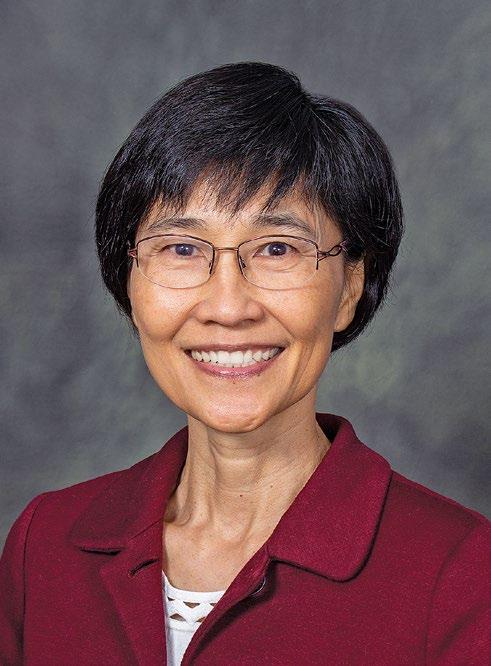 Samuel D. Harris Collegiate Professor of Dentistry
Samuel D. Harris Collegiate Professor of Dentistry
n ’ s Message
Dea
Spring 2023 Volume 39, Number 1
M Dentistry is published twice a year for alumni, students, faculty, staff and friends of the School of Dentistry. See the school website at www.dent.umich.edu for more news and features.

Interim Dean …Jan Hu

Director of Marketing & Communications
Raymond Aldrich
Writer/Editor Lynn Monson
Graphic Designer Ken Rieger
Photographers Lynn Monson, Ken Rieger
Celia Alcumbrack, Mary Lewandowski
University of Michigan School of Dentistry

Alumni Society Board of Governors:
Terms Expire Fall 2023:
Karen Beckerman, BSDH ‘95, Plymouth, Mich.
Jake DeSnyder, DDS '67, Plattsburgh, N.Y.
William Mason, DDS '81, MS '84, Saginaw, Mich.
Michael Palaszek, DDS '82, Grand Rapids, Mich.
Michelle Velez, BSDH ‘98, Royal Oak, Mich.
Lisa Wendling, DDS ‘93, MS ‘96, New Lothrop, Mich.
Terms Expire Fall 2024:
Chair: Michael Behnan, MS ‘79, Rochester Hills, Mich.
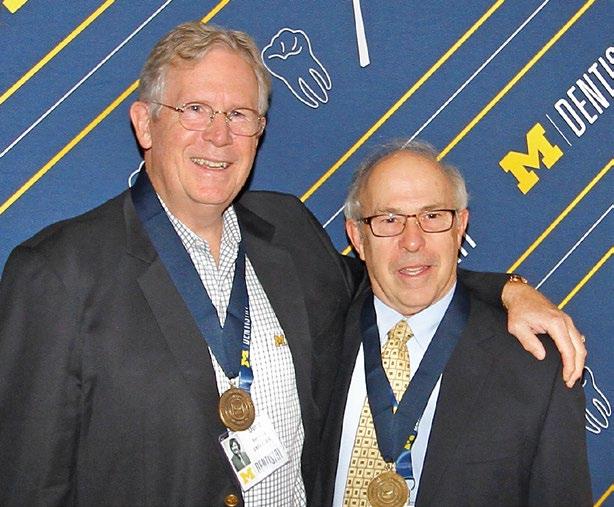
Theresa Hull, BSDH ‘11, Ann Arbor, Mich.
Sara Kellogg, DDS ‘07, Saline, Mich.
Amin Jaffer, DDS ’97, Ann Arbor, Mich.
Mona Riaz, BSDH ’12, MS ‘20, Farmington Hills, Mich.
Riley Schaff, DDS ’17, Ann Arbor, Mich.
Terms Expire Fall 2025:
Janice Pilon, DDS ’93, Hanover, N.H.
Debra Lisull, DH Cert ' 74, BSDH '79, DDS '83, Ann Arbor, Mich.
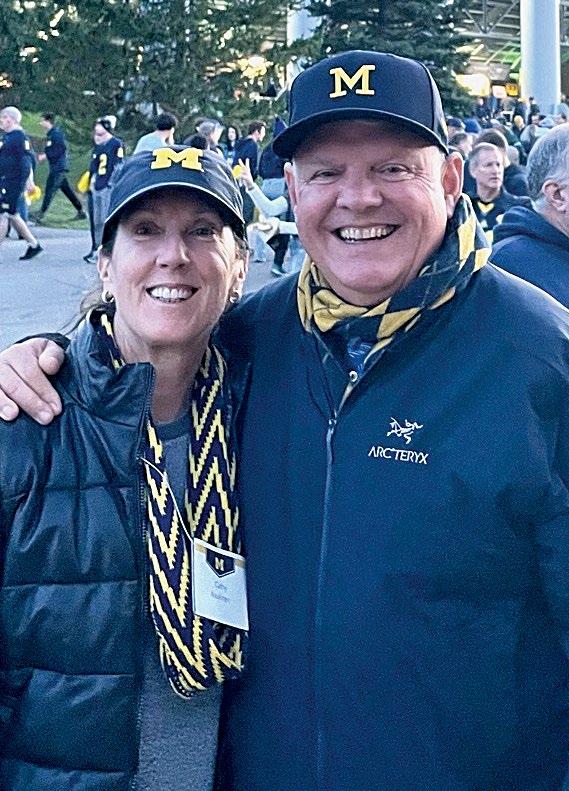
Julie Thomas, DDS '89, Ann Arbor, Mich.
Allan Padbury, Jr, DDS '99, MS '02 MS, Jackson, Mich.
Jennifer Cullen, BSDH '12, Ypsilanti, Mich.

Brittany Forga, BSDH '10, Van Buren Township, Mich.
Ex Officio Members:
Jan Hu, Interim Dean
Carrie Towns, Chief Development Officer, Alumni Relations and Development
The Regents of the University:
Jordan A. Acker, Michael J. Behm, Mark J. Bernstein, Paul W. Brown, Sarah Hubbard, Denise Ilitch, Ron Weiser, Katherine E. White, Santa J. Ono (ex officio)
Send comments and updates to: dentistry.communications@umich.edu or Communications, School of Dentistry, 1011 N. University Ave., Ann Arbor, MI 48109-1078
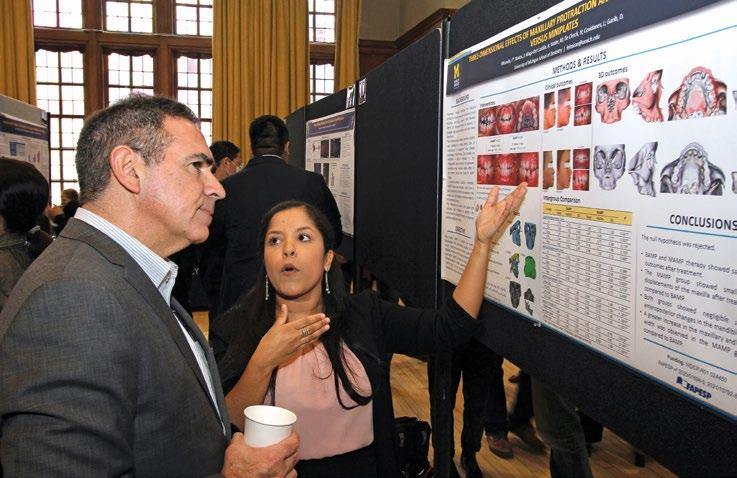
The University of Michigan, as an equal opportunity/affirmative action employer, complies with all applicable federal and state laws regarding nondiscrimination and affirmative action. The University of Michigan is committed to a policy of equal opportunity for all persons and does not discriminate on the basis of race, color, national origin, age, marital status, sex, sexual orientation, gender identity, gender expression, disability, religion, height, weight, or veteran status in employment, educational programs and activities, and admissions. Inquiries or complaints may be addressed to the Senior Director for Institutional Equity, and Title IX/Section 504/ADA
Coordinator, Office of Institutional Equity, 2072 Administrative Services Building, Ann Arbor, Michigan 48109-1432, (734) 763-0235, TTY (734) 647-1388. For other University of Michigan information call (734) 764-1817.
© 2023 Regents of the University of Michigan
2
14
19 ON THE COVER
7 22 24
DENTAL HYGIENE
Ava Carruthers of Holland, Ohio, was a week away from having her braces removed when this photo with her treatment team was taken in the Orthodontics Clinic earlier this spring.
Clockwise from left are second-year resident Dr. Sara Tinawi; adjunct clinical lecturer Dr. T.J. Robinson; and Dr. Hera Kim-Berman, director of the Graduate Orthodontics Program.
27
In this Issue
SCHOOL
STUDENTS ALUMNI
FEATURES
FACULTY RESEARCH
A Century of Orthodontics
Program celebrates 100 years of leadership and excellence
After 100 years of growth from a fledgling specialty to a world-class educational enterprise, it’s still the people that make the University of Michigan School of Dentistry orthodontic program special.
Dr. Nan Hatch, Chair of the Department of Orthodontics and Pediatric Dentistry, says residents in the program and new graduates may not understand or appreciate the quality of their educational experience while they are in the program, but they soon find out after they graduate and begin their careers.

“A year or so later, alumni will come up at meetings and say things like: ‘Oh, my goodness, I knew we were good,” Hatch says, paraphrasing the common conversations, “but I didn’t realize how much I learned here compared to my peers until I got out and started talking to my friends who went to other programs.’”
That sort of revelation is a testament to the dedication that all members of the program – faculty, staff, alumni and residents – put into the program, Hatch said. “As chair, my primary objective is to maintain the excellence and innovation that is known to be University of Michigan Orthodontics, such that our alumni will continue to bleed maize and blue.”
Such perspective is especially meaningful during this special year that marks 100 years since the program was established at Michigan, when it became the first such graduate degree-granting program in the United States.
Dr. Hera Kim-Berman, the current Graduate Orthodontic Program Director, said student applicants who visit the program usually want to see the clinic – where the knowledge is created, and where the “magic” happens. She said U-M residents will reply with words to the effect of: “Well, it’s just the clinic. It’s just dental chairs. In a relative sense, there’s really nothing to see.”
And, indeed, it’s not about the facility, Kim-Berman says. “It’s the interaction of the people, the back and forth, and all the hard work that people put in at all levels here. Many people who came right out of this program are giants in their field. And I think that really creates this aura of excellence.”
Interim Dean Jan Hu, in her welcome at this year’s Moyer’s Symposium, said the orthodontics centennial is an opportunity to reflect on the incredible amount of learning and progress over the course of 100 years. “Imagine the culture of dentistry in 1923 as Dean Marcus Ward directed Dr. Leroy Johnson to start a new program without any models to follow,” she said. “A year later, the job of chair was given to Dr. George Moore, who just that spring had graduated from our school as one of the first two students to receive the new Master’s of Science degree in Orthodontics. From those early days, a model of excellence was gradually built, year by year, decade by decade, research advancement by research advancement. It is truly remarkable how far orthodontics and orthodontics at the University of Michigan have come.”
2 M Dentistry | Spring 2023 FEATURES FEATURES
In the beginning
Orthodontic training was available at U-M prior to the establishment of the Graduate Program, but the training was at the level of dental students and was limited in its extent and focus. Dr. William Dorance, a U-M faculty member in prosthetics and dental metallurgy from 1877-1902, was identified as the first faculty member to teach orthodontics, from 1883-1902. “Lectures in Orthodontia” were first mentioned in the 1893 U-M College of Dental Surgery Announcements.
Three decades later came a galvanizing event for dental specialties. Dr. William Gies, a Columbia University professor of biochemistry and widely credited as founder of modern dental education, published The Gies Report, “Dental Education in the United States and Canada.” This landmark report in 1926 established the importance of dentistry as a healing science, and as an essential component of higher education within the health professions.
The Gies philosophy that was the foundation for the report struck a chord with Dr. Marcus Ward, who was Dean of the dental school. He decided the school should have an orthodontic program at the graduate student level. Ward named Dr. Leroy Johnson as the first “Chair of Orthodontia,” initiating the program in 1923.
At its September meeting that year, the U-M Board of Regents authorized the “sum of $1,500 to provide equipment and quarters for the use of Dr. A. Leroy Johnson, Professor of Orthodontia in the College of Dental Surgery.” The Graduate Degree, a Master of Science in Orthodontia, was first offered in the academic year 1923-24. Drs. George Moore and Frank Cartwright are granted the first degrees in 1924.
While Dr. Johnson quit in 1924 after just one year, in part because he did not see eye to eye with Ward on some matters, the die had been cast. A Graduate Orthodontic Program at the University of Michigan was born and a distinguished 100-year history was set in motion.
To replace Johnson, Ward turned to one of the two first graduates that year, Dr. George Moore, naming him chair in 1924. He served in that capacity for 28 years and is credited with fully establishing the program at a time when U-M stood nearly alone in offering dental specialty
training to graduate students leading to an MS degree. Moore gained recognition for strong and focused leadership that proved essential for creating the fundamental program tenets that still hold true today, including a vision for excellence in education, patient care and research. Moore served as chair until his death in 1952.
The Moyers Impact
In 1953, a remarkable figure came to Ann Arbor, a leader and researcher whose footprint remains firmly implanted in the spirit of Michigan Orthodontics today. U-M recruited Dr. Robert E. Moyers from the University of Toronto to chair the Department of Orthodontics at Michigan.
Moyers had received his orthodontic training and a PhD from the University of Iowa, then became a highly regarded faculty member at the University of Toronto, where he was the founding Chair of Orthodontics in 1949, the first such program in Canada. Among his many other accomplishments in Toronto, he established the Burlington Growth Center in a town 30 miles from Toronto, and the Craniofacial Anomalies Clinic at the Hospital for Sick Children in Toronto.
Moyers carried that developmental perspective to U-M, where he brought the U-M Center for Human Growth and Development to fruition in 1964. The center was established as a university-wide interdisciplinary unit to better understand childhood growth and development, including many aspects of dental and craniofacial growth. Under Moyers’ leadership, the Center drew distinguished scholars from all over the world and gained international prominence. He served as the Chair of Orthodontics until 1966 and directed the Center for Human Growth and Development until 1980.


The memory of Moyers, who died in 1996, is honored annually during the Orthodontic Program’s annual Moyers Symposium, which celebrated its 50th anniversary this year.

The James Harris Years
The appointment of Dr. James Harris as Chair of Orthodontics in 1966 began an extended run through 1981 in which the program focused on offering residents excellence in patient-centered clinical training in addition to research. Harris came steeped in the U-M experience, having graduated from its dental school in 1954, completed an MS in genetics followed by an MS in orthodontics in 1963.
Despite the fact he had a research-focused background, Harris wanted the department to emphasize the clinical aspects of orthodontics. He went to Dean William Mann and together they put together a program aimed at hiring the best orthodontic practitioners they could find in Michigan to become faculty members. Inclusion of this group brought increased time for clinical teaching and patient care at the university.
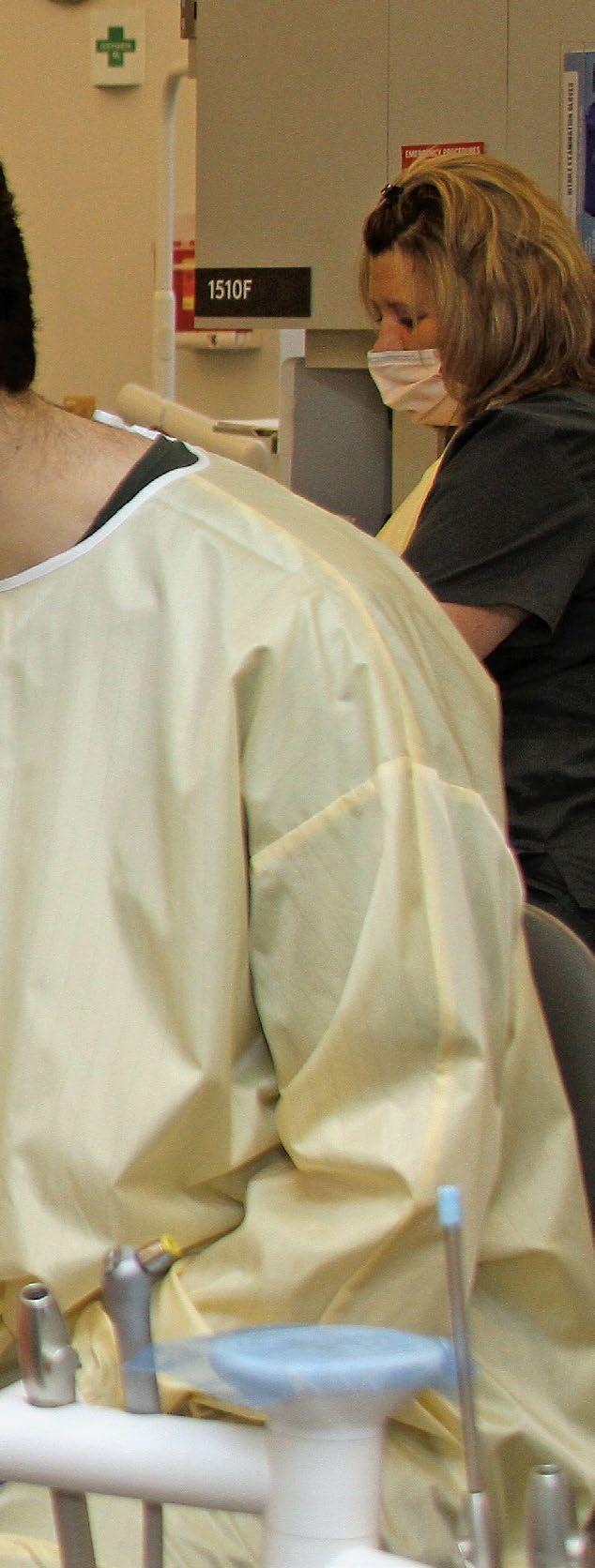
Spring 2023 | M Dentistry FEATURES 3 Continued
Adjunct orthodontics professor Dr. Steven Lash shares guidance with second-year resident Dr. Sara Tinawi (left) as he examines her young patient. At right is first-year DDS student Philip Alkhouri, who was observing the treatment procedure.
Dr. George Moore
Dr. James Harris
Dr. Robert Moyers
Timeline: Ortho at 100
1923 Dr. Marcus Ward, dean of what was then called the College of Dental Surgery, initiates an orthodontic program at the graduate student level. Dr. Leroy Johnson is named the first chair and classes are offered in the academic year 1923-24.
1924 Drs. George Moore and Frank Cartwright are granted the first University of Michigan degrees in Orthodontia in 1924.
1924 The ink on his diploma as one of the program’s first two graduates was barely dry when Dr. George Moore was named Chair of Orthodontia. He serves for 28 years until his death in 1952.
1940 The Kellogg Building is completed for graduate and postgraduate dental studies. By this time, the Orthodontic Graduate Program had been expanded to two academic years.
1941 U-M Orthodontic faculty member Dr. Paul V. Ponitz receives license “No. 1” from the Orthodontic Specialty Board of the State of Michigan.
1953 Dr. Robert Moyers is recruited from the University of Toronto to chair Orthodontics at U-M.
1964 Moyers establishes the U-M Center for Human Growth and Development. The center seeks to better understand childhood dental and craniofacial growth. The center remains active as a university-wide interdisciplinary unit until 2021.
1966 Dr. James Harris appointed Chair of Orthodontics. He promotes a focus on clinical patient-centered training along with research.
1974 U-M establishes the Moyers Symposium, a three-day event held each spring that draws speakers and experts from around the world.
1981 Dr. Surender Kumar Nanda, a highly respected instructor, serves as acting chair for a year.
1983 Dr. Peter Vig named interim chair of the program, serving until 1987.
1987 Dr. James McNamara appointed interim chair of Orthodontics, serving for four years.
1989 McNamara takes the lead in establishing the Graduate Orthodontic Residents Program, or GORP, which each summer continues to draw residents from the United States and Canada for a weekend of networking, education and fun.
1991 Dr. Lysle Johnston appointed Chair of what is now named the Department of Orthodontics and Pediatric Dentistry. He serves more than a dozen years, until 2004.
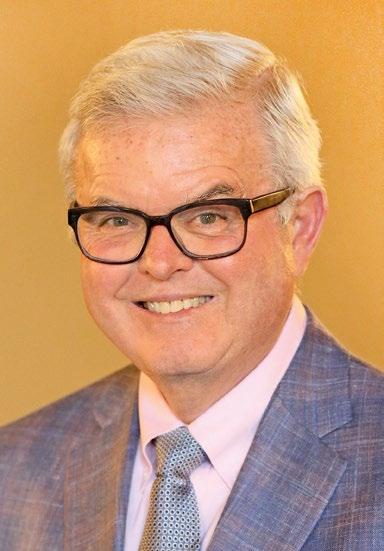
2002 Dr. Katherine Kelly creates the U-M Craniofacial Orthodontic Clinic.
2004 Dr. Sunil Kapila appointed Chair of the Orthodontics and Pediatric Dentistry Department, serving in the leadership role for a decade.
2011 Dr. Lucia Cevidanes, a world-renowned expert in three-dimensional imaging, joins the faculty.
2012 Through the efforts of Dr. Katherine Kelly, U-M is able to endow and begin the U-M Craniofacial Orthodontics Fellowship
2016 Dr. Nan Hatch is named Chair of Orthodontics and Pediatric Dentistry.
2016 Dr. Hera Kim-Berman is named Graduate Orthodontic Program Director after serving as Interim Program Director for a year.
2023 A century is celebrated during the 50th annual Moyer’s Symposium weekend, which included an Alumni and Friends Reception at Michigan Stadium.
A Century of Orthodontics (Continued)
“I wanted (external faculty) to have half a day to prepare their lectures, so that when they were at our school, they gave seminars in the morning, and then went over cases with patients in the clinic during the afternoon,” Harris said in an interview at his Ann Arbor home last year. Thus, each faculty member from the clinical practice realm spent a whole day with the graduate students, teaching the challenging aspects of Tweed orthodontics, that is, the bending of wires, a process Harris calls the “grandfather of orthodontics.”
Harris said he also sought to develop a broader understanding of the variations between patient groups. To that end, he brought a fulltime professor of anthropology, Dr. Mel Baer, from the University of Chicago, to the department. The move reflected Dr. Harris’ deep appreciation for the fact that, in addition to working with teeth, orthodontists are dealing with skulls, growth and development, and human variability and diversity. “The big thing was to look at each individual as an individual, and not as a mean, on a curve of a population,” Harris said.
When Harris retired in 1981 after 16 years of leadership, he was followed by two interim leaders who served shorter stints. Dr. Surender Kumar Nanda was acting department chair from 1981-82. He was followed by Dr. Peter Vig from 1983-87. Under Vig’s leadership, the curriculum content was further standardized, and the department continued to grow.
Jim McNamara’s many roles
Few people have cast a more varied and positive shadow on U-M Orthodontics than Dr. James McNamara. He has long been a key fixture, having played myriad roles, including interim chair from 1987-91, faculty member, long-time local practitioner, world-renown researcher and lecturer, and co-organizer for two of the program’s marquee events – the Moyers Symposium and the Graduate Orthodontic Resident Program, or GORP.
Colleagues say that throughout his 50-plus year association, McNamara retained a powerful enthusiasm for the U-M Orthodontic Program, for his private practice in Ann Arbor and for the education in and profession of orthodontics. After a long period serving as the Graber Endowed Professor in Orthodontics, he is now a Professor Emeritus of Dentistry, Professor Emeritus of Cell and Developmental Biology, and Research Professor Emeritus of the Center for Human Growth and Development.
McNamara was educated in California, earning his dental and orthodontic degrees at the University of California at San Francisco. He earned his PhD in anatomy from U-M in 1972 and began teaching in the U-M Orthodontics Program as professor in 1984.
Beginning in 1971, McNamara maintained a practice in Ann Arbor, which he eventually shared with his daughter, Dr. Laurie McNamara McClatchey. “Being able to move seamlessly between the university laboratory and clinical practice has been a hallmark of his career,” wrote a colleague, Rolf Behrents, in an article announcing that McNamara had received the Lifetime Achievement Award for
FEATURES M Dentistry | Spring 2023 4
Dr. James McNamara
Orthodontic Research from the American Association of Orthodontists, one of many prestigious awards McNamara has received.
The GORP event was born, as McNamara recalls it, when he and two residents, Drs. Pat Nolan and Gary Starr, were talking about such an event after a holiday departmental gathering involving faculty, residents and staff. In 1989, the discussion led to a program that now draws orthodontic residents from the United States and Canada for a long weekend of networking, professional education and fun in Ann Arbor every other year.
Lysle Johnston’s quest for best
Dr. Lysle Johnston, who served more than a dozen years as Chair of the Department of Orthodontics and Pediatric Dentistry from 1991-2004, focused on managing and successfully running a department whose graduates excelled in both research and in patient care. “Running an orthodontics department was like a game,” he said in an interview last year. “The ways you can tell you have won include good research, good faculty and good clinicians. We built a clinical faculty that was absolutely fabulous.”
The Depar tment History Project
This article by Geoff Larcom is excerpted from the book, “100 Years of Graduate Orthodontics at the University of Michigan School of Dentistry,” which he wrote to mark the centennial. Larcom is a writer who lives in Ann Arbor. To read the entire book online, go to this web address https://myumi.ch/m7JP3 or use the QR code.

To see a short video of the Ortho 100 reception at the Big House, go to https://myumi.ch/EPpx5
Johnston grew up in the small town of East Jordan, Michigan. He entered the University of Michigan School of Dentistry in 1957, for both his DDS (1961) and MS (1964). After graduation, his academic and career stops included Queen’s University of Belfast in Ireland, Case Western Reserve University and then St. Louis University as Department Chair.
In 1991 he was recruited to Michigan, where he was appointed as the Robert W. Browne Professor of Dentistry and Chair of the U-M Department of Orthodontics and Pediatric Dentistry, serving until his retirement. Under his direction, the Graduate Orthodontic Program produced more than 300 orthodontists. He and his students won numerous research awards over the years and Johnston presented at numerous national and international conferences. Among his honors is the AAO Lifetime Achievement Award.

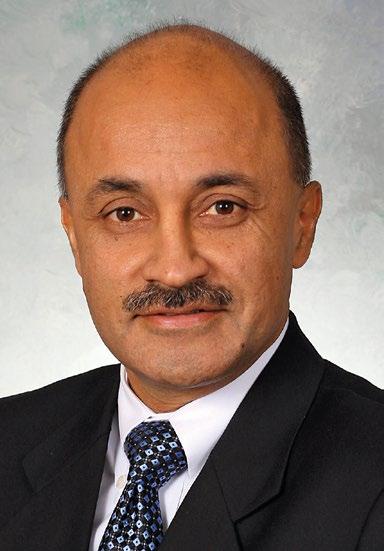
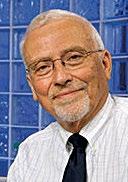
McNamara describes Johnston’s career this way: “Whether as a department chair, mentor, lecturer, or researcher, his focus never has strayed much beyond the day-to-day concerns of the clinician. He has served as a key spokesman who has questioned, scolded, asked for data, and generally served as resident skeptic when new (and often unproved) techniques and protocols had been advocated. Lysle Johnston has served our profession and our specialty well. … His work has made and continues to make a difference to orthodontics, to craniofacial biology, and to dentistry.”
Faculty emphasis by Sunil Kapila
Recruiting exceptional faculty was one emphasis for the next Chair, Dr. Sunil Kapila, who served in that role for a decade from 2004-14. In addition to hiring the current chair, Dr. Nan Hatch, as a postdoctoral research fellow, he recruited world renowned researcher Dr. Lucia Cevidanes from the University of North Carolina along with Dr. Hera Kim-Berman, who currently serves as the U-M Graduate Orthodontic Program Director.
FEATURES 5 Spring 2023 | M Dentistry
Dr. Lysle Johnston
Dr. Sunil Kapila
Dr. Nan Hatch, chair of the Department of Orthodontics and Pediatric Dentistry, welcomes alumni and friends to the Centennial Celebration Reception on March 4 at Michigan Stadium. More than 450 people attended the event.
Continued
Kapila was educated as a dentist at the University of Nairobi in Kenya. He received his MS degree in orthodontics from the University of Oklahoma and his PhD in Oral Biology from the University of California at San Francisco. His research focused on the hormonal basis of TMJ degeneration and periodontal bone biology. He published many peer-reviewed papers, chapters and proceedings on these topics, and on orthodontic biomaterials, biomechanics and 3-D imaging.
Kapila supported departmental growth in the area of education in the treatment of patients with craniofacial anomalies such as cleft lip/palate. In collaboration with Dr. Katherine Kelly, and through a generous patient family donation, an endowed fellowship in Craniofacial Orthodontics was created.
When Kapila left to return to UCSF, two interim chairs, Dr. R. Scott Conley in 2014 and Dr. Jan Hu in 2015, each led the Orthodontics and Pediatric Dentistry Department for a year.

Nan
Hatch: ‘You have to lead’
Dr. Nan Hatch, who had been at the U-M dental school for more than 10 years, was chosen as Chair in 2016 after the School of Dentistry conducted a competitive national search to fill the position.

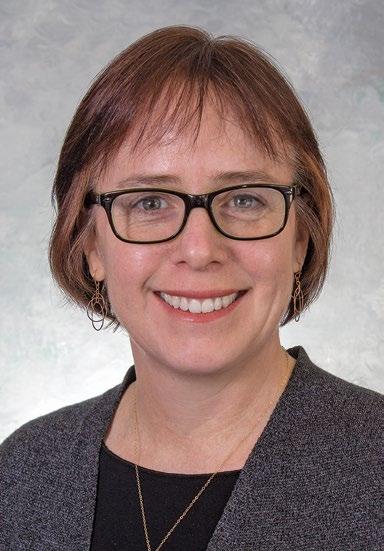
Originally from Massachusetts, Hatch received her DMD from the Harvard School of Dental Medicine with honors in research. She then moved across the country to pursue clinical orthodontic training in combination with research training at the University of Washington in Seattle. After completing her PhD in Cell and Molecular Biology in 2005, she was recruited to U-M, where she advanced from postdoctoral research fellow to a full-time orthodontic faculty position.
As an internal candidate for Chair, she knew the dental school well. She initiated the Orthodontic Faculty Practice within the orthodontic clinic; treated patients in the faculty practice; taught predoctoral dental students and orthodontic residents in clinical and didactic arenas; served as the Orthodontic Research Director, developing a course and specific milestones to promote successful achievement of MS
research projects by the orthodontic residents; ran her research lab; and provided service to the program, department and school.
Today, she brings a management approach that emphasizes empathetic faculty and staff leadership, technology, patient care, research and professional service. “I just wanted to make sure that we had a Chair who really was going to put their heart into it. To put their head into it, yes, but also their heart …This is very much a leadership position. This isn’t just about clinical practice or your particular expertise in the field. You’ve got to lead.”
One of her goals is to incorporate new clinical technologies balanced with traditional techniques to create well-rounded and highly versed orthodontic residents ready to become master clinicians. “Our students are going to be treating with clear aligners, and they’re going to be using intraoral scanners and digital software to visualize and manipulate those scans, so they need to learn those skills.”
Hatch provides strong support for both faculty and resident research, making sure faculty can protect research time and receive department resources. To support resident research, she developed a formal course and a scheduled list of milestones as residents work to develop and write their master’s research projects. “There is no expectation that orthodontic residents will become researchers, but successful completion of an MS project provides critical thinking skills that will enable them to distinguish real data from opinion, which will be useful throughout their orthodontic careers as new techniques and philosophies continue to arise.”
Hatch cites what she calls the “Michigan knowledge base,” a strong understanding of diagnosis, treatment planning and mechanics. “Not everybody is taught the way these residents are taught,” she said. “I’m not saying that we’re the only good program, but when alumni go teach at another orthodontic program, they’ll be teaching from their Michigan knowledge base, which is deep and comprehensive.”
That knowledge is also paired with an expectation of service to the profession, to the community, and to orthodontic education.
“The reality is that these people are going to be much more fortunate than many others in their community,” Hatch says. “And they’re highly capable, highly skilled, highly intelligent, typically with good people skills. And we just really want them to remember how fortunate they are and that it’s important to give back and also to spread the Michigan knowledge.”
6 FEATURES M Dentistry | Spring 2023
Dr. Nan Hatch
At the centennial celebration at Michigan Stadium, Jim McNamara (center) poses with members of the 2005 orthodontics class, including his daughter. From left are Drs. Marsha Beattie, Laurie McNamara McClatchey, Heather Gietzen and Steven Charchut.
A Century of Orthodontics (Continued)
Lysle Johnston greets well-wishers during the centennial reception at Michigan Stadium. Here he chats with his classmate Dr. Daniel (DDS 1961, MS 1965) and Barbara Balbach. At left is Dr. Jay Bowman and in the background is Dr. Fedon Livieratos (MS 1993).
School Announces Major Gift to Fund Graduate Fellowships
Jamie and Cathy Kaukinen pay it forward for Canadian graduate students
A School of Dentistry alumnus who earned his graduate degree in prosthodontics in 1993 is making a major financial gift to support future generations of graduate students.
Dr. Jamie Kaukinen and his wife Cathy are committing $10 million to create the Kaukinen Family Fellowships to fund the tuition of graduate students from Canada who come to U-M for any of the dental specialty programs. It is one of the largest single financial commitments in school history.

Kaukinen, a native of Thunder Bay, Ontario, earned his DDS degree at the University of Toronto Faculty of Dentistry, then joined the U-M graduate prosthodontics program for his master’s degree from 1991-93. He credits the U-M faculty with providing worldclass training and professional connections that significantly advanced his successful dentistry career in Victoria on Vancouver Island in British Columbia.
Last year, as the 30th anniversary of Jamie’s U-M graduate degree approached, the couple incorporated the financial gift to the dental school into their estate planning. They said their goal is to “create a lasting legacy that improves the lives of patients in Canada and the U.S. by receiving treatment from Canadian dentists who obtain state-of-theart dental graduate specialty training at the University of Michigan funded by our fellowships.”
Interim Dean Jan Hu said the School of Dentistry is grateful for this remarkable and important gift. “The generosity and forwardthinking vision of Jamie and Cathy Kaukinen in establishing this fellowship program is extraordinary,” Hu said. “It strengthens the school’s longstanding commitment to excellence in the graduate programs. The
fellowships will be a substantial incentive that draws exceptional dentists to Michigan to contribute to our world-class clinical training and research, just as Dr. Kaukinen did in the early 1990s. We greatly appreciate this initiative to pay it forward for future graduate students and for the advancement of oral healthcare in general.”
During his 22 years of practicing in Victoria, Kaukinen specialized in prosthodontics and
implant dentistry, with an additional focus on maxillofacial prosthetics for cancer patients. Over time he purchased two other practices, creating one of the leading prosthodontic and dental implant clinics in western Canada with its own dental laboratory, imaging and surgical services. Cathy Kaukinen initially worked at the practice as a hygienist and later became practice manager.
SCHOOL
7 Spring 2023 | M Dentistry SCHOOL
Continued
Jamie and Cathy Kaukinen during a visit to the School of Dentistry last fall.
In 2015, the Kaukinens sold the practice and turned their attention full-time to an outside business interest in industrial warehouse development in Canada. They now split their time between Victoria and Scottsdale, Arizona.
Kaukinen knows first-hand that Canadian students face an additional financial challenge when they wish to study in the U.S. because of the often-significant variance in the currency exchange rate between Canadian and U.S. dollars. It was an issue for Kaukinen in 1990 when he set his sights on graduate study at U-M. He is grateful that his financial burden was eased after he received a two-year Donald Matheson Springer Fellowship for University of
Toronto graduates who enroll in graduate programs at U-M.
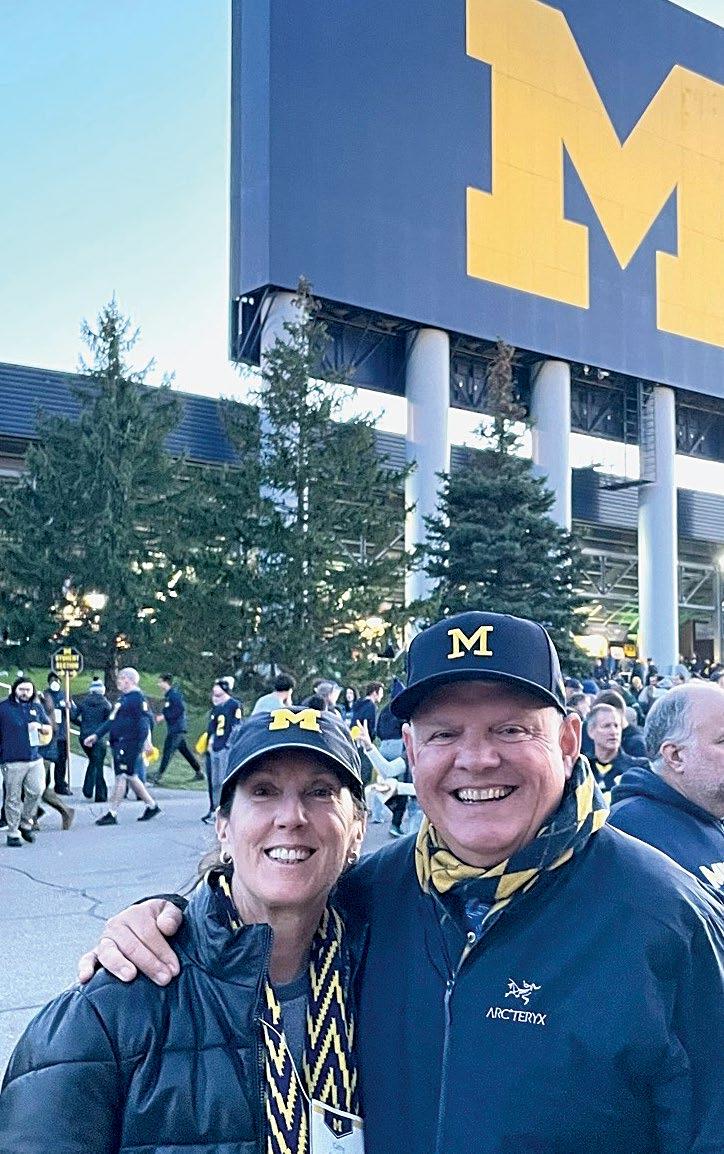
His interest in attending grad school at U-M was prompted by numerous ties between prominent dental faculty at Toronto and U-M, including noted prosthodontist Dr. George Zarb. Kaukinen remembers his admissions interview at U-M with the late Dr. Brien Lang, who was chair of what was then called the Department of Complete Denture Prosthesis. “He welcomed me with open arms. He said he would give me the best learning experience and the hardest two years of work I would ever have in my life.”
“It was an awesome time,” Kaukinen said. “The University of Michigan was a center of excellence for dental implants, and that was one of my early interests. Dr. Lang was my mentor and took extra interest in my career. I was able to work with him on the weekends to treat his faculty patients, and he helped me establish my thesis.” His thesis, “The influence of occlusal design on simulated masticatory forces,” won a grant through the Tylman Research Program supported by the American Academy of Fixed Prosthodontics. The research was later published in the Journal of Prosthetic Dentistry. Other faculty members also were generous in sharing their expertise in both traditional and cutting-edge prosthodontic treatments and techniques, including faculty members Drs. Michael Razzoog and Peter Yaman. Kaukinen said one of the strengths of the Michigan pros program was that faculty let students explore interdisciplinary paths. For example, periodontics professor Dr. Robert O’Neal introduced Kaukinen to implant training and another perio faculty member, Dr. Hom-Lay Wang, offered surgical training. Kaukinen also was part of treatment teams for cancer patients at Michigan Medicine. His master’s thesis provided interprofessional
opportunities when he collaborated with researchers at the U-M College of Engineering.
“Those connections with faculty and various interdisciplinary areas early on in my career were a stepping stone for me getting into a number of specialty organizations,” Kaukinen said. “It was a great advantage when you are a young dental specialist getting exposure to these different groups. Having new mentors to help early in my career was very formative for me.”
The close ties to the U-M dental school continued once Kaukinen was practicing on his own. In 1998, he was invited by Lang to participate in a Procera CAD/CAM conference in Ann Arbor. Again in 2007, Kaukinen was invited to Lang’s Nobel Guide Implant Surgery conference at U-M. “Being invited back to world meetings held in Ann Arbor showed me that the University of Michigan wanted to maintain its relationships with its students,” Kaukinen said. “The relationship was important enough for the university to stay in contact with me and it became reciprocal.”
The Kaukinens have returned to Michigan over the years to visit relatives of Cathy and attend football games. Last year, they returned for the Michigan State game and arranged for a tour of the newly renovated School of Dentistry. They were impressed by the many new features and the commitment of administrators to raise funds for the project. “That crystallized our plans to leave money to the university and to establish our fellowship program,” Jamie Kaukinen said. “We thought if we can help future Canadian students come to Michigan, it’s good for not only those students but it will also help the dental school get topquality students. It seemed like a win-win situation for everyone.”
Kaukinen wants other grad students to be able to emulate his experience of gaining outstanding training at Michigan, then using that expertise for the benefit of countless patients over many years of dental practice. “Michigan is the world leader in dental education,” he said. “Having that available to Canadian students is a benefit to everyone. Some of the students will go back to Canada, some will stay in the States, some will go elsewhere. Overall, patients are the ones who will ultimately benefit.”
8 SCHOOL M Dentistry | Spring 2023
Major Gift (Continued)
Jamie and Cathy Kaukinen are avid Michigan football fans, here at Michigan Stadium for the game against Michigan State last fall.
University of Michigan President Santa Ono (far right) listens to presentations by School of Dentistry faculty at the monthly faculty meeting in February. President Ono was visiting the dental school for the first time since taking office last October. He gave an overview of his first three months in office, which focused on listening and consulting across the university about its needs and its future. He discussed the strategic visioning process he has implemented, which will guide where funding and resources are directed within the campus master plan. After his presentation, he stayed for faculty presentations on technology upgrades and the Victors for Veterans community outreach program.

U-M President Ono Visits School
School Presents Annual Ida Gray Awards
Three members of the School of Dentistry community were honored with Ida Gray Awards in March during the school’s annual Diversity, Equity and Inclusion Day, organized by the school’s Diversity, Equity and Inclusion Multicultural Affairs Committee. Students, faculty and staff nominate individuals who have contributed to the advancement of diversity and improvement in the climate for work, learning, research and patient care. The award is named for Dr. Ida Gray, the first Black woman in the country to earn a DDS when she graduated from the U-M dental school in 1890. This year’s honorees are:
STAFF:
Todd Brown, a senior research administrator in the Office of Grants and Contracts. A nominator said Brown continuously offers his talents in maintaining a warm, respectful, professional and caring climate at the school.
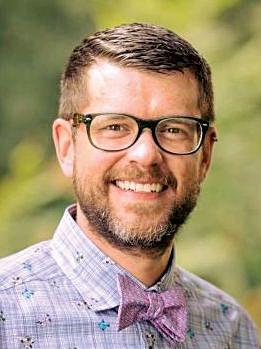
“Todd has an uncanny ability to create new dialogue among persons of diverse cultural backgrounds within the Office of Grants and Contracts, or working with the Office of Research at U-M, with other departments at U-M, and with collaborating institutions nationally and internationally,” the nominator wrote. “It is impressive how Todd shows creativity in creating a climate of care, acceptance and welcome within our Office of Grants and Contracts that is a role model for his colleagues.”
FACULTY:
Dr. Colonya Calhoun, adjunct clinical associate professor in the Department of Oral and Maxillofacial Surgery/Hospital Dentistry. A nominator praised Calhoun’s mentoring of predoctoral students, Oral and Maxillofacial Surgery residents and dental assistants, as well as a “super-caring” approach with patients and their families. “She displays a strength of leadership and knowledge in all she does,” the nominator said. “She embodies a commitment to diversity and has a beautiful welcoming spirit to all she encounters. She serves as a willing mentor and role model to all students she encounters.”

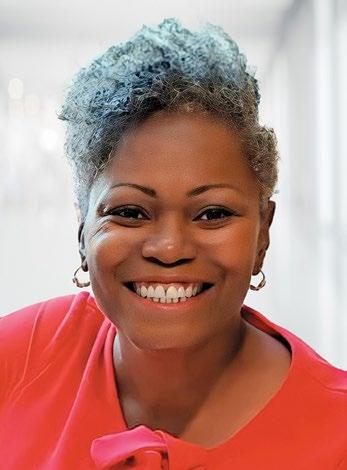
STUDENT:
Brea Fleming, a fourth-year dental student who graduated in May. Fleming was cited for her work in welcoming new students and engaging with existing students across the school. She regularly creates videos and takes photos that she shares widely, including in her role the last two years as historian of the U-M chapter of the Student National Dental Association. “She has taken her time to show us how joyful and powerful it is to be with one another through her poignant videos she’s shared during conferences and events such as King’s Feast.” She was also cited for outstanding patient care, willingness to share her dentistry knowledge with other students, and her willingness to be a sounding board for others on personal issues.
9 Spring 2023 | M Dentistry SCHOOL
School Renovation Project Receives
National and State Construction Awards
The School of Dentistry’s major Blue Renew renovation project completed last fall has received three significant national and state construction awards.
The Blue Renew general contractor, Granger Construction Company, received a 2023 Build America Award from the Associated General Contractors of America at the organization’s national conference in Las Vegas, Nevada, in March. The awards recognize excellence in the building industry. Granger won in the category of “Construction Management, New or Renovation, for projects of more than $100 million.”
The judges cited the difficulty of renovating 176,000 square feet of the dental school while keeping the building open for students, faculty, staff and patients. The work included constructing a new four-story building for research labs and offices in the school’s former courtyard; extensive electrical and air handling improvements; and a tunnel connection to an adjacent building. Granger completed the work in 27 phases covering three and a half years.
The national organization’s state chapter –Associated General Contractors (AGC) of Michigan – also honored Granger for Blue Renew, also in the Construction Management
category. Granger received one of AGC’s four 2023 Build Michigan Awards at the state meeting in March. The dental school project was selected from among numerous nominations of impressive major building projects completed around Michigan in 2022.

Like the national award, the state group emphasized Granger’s difficult task of completing the four-year project while the dental school continued to educate students and treat patients in its clinics. Strategic planning allowed Granger to complete the renovation of the clinics in phases, with rotating closures of some clinics while others remained open. Overall, the project replaced 250 operatories while keeping at least 190 active throughout the construction. The complex plan required that Granger coordinate with numerous mechanical and electrical departments, the AGC said.
In an AGC video highlighting the awardwinning project, Paul Roller, project director for Granger, said: “I’m most proud of the team’s flexibility and willingness to provide the school’s needs above the construction. That mindset, along with creativity and perseverance, made this project possible.”
Granger Construction has Michigan offices in Lansing, Grand Rapids and Troy, and in Columbus, Ohio.
A second national award for Blue Renew is a LEED Silver certification from the U.S. Green Building Council in recognition of sustainability efforts. The Leadership in Energy and Environmental Design award recognizes sustainability efforts to create healthy, highly efficient and cost-saving green buildings on one of four levels: Certified, Silver, Gold and Platinum. Sustainable features include low-flow bathroom fixtures, which aim to reduce potable water use by more than 22 percent when compared with a similar building in compliance with the 2015 Michigan Plumbing Code; nearly 23 percent energy cost savings when compared with a similar building in compliance with normal codes; a ventilation system that meets requirements for optimal occupant comfort; and low-emitting materials, including adhesives, sealants, paints, coatings and flooring systems. The project also repurposed space to provide additional building square footage without disturbing undeveloped land.
Blue Renew was the school’s biggest renovation in 50 years, was more than 10 years in the planning and cost about $140 million.
10 SCHOOL M Dentistry | Spring 2023
New Display Features Albert Richards’ Floral Radiographs


Six strikingly beautiful images of flower radiographs by the late professor Albert Richards now grace the walls of a thirdfloor lobby at the School of Dentistry. Coordinated by dental school Chief of Staff Erica Hanss, the image installation is part of an ongoing addition of artwork after the completion last year of Blue Renew, the school’s major renovation and expansion.
Three of the captivating radiograph reproductions are positive images on white backgrounds and three are solarized versions with black backgrounds. They are accompanied by a panel with a photo of Richards and his biographical information.
A faculty member at the school from 19401982, Richards was a world-class expert on dental radiology. He used his expertise with X-rays to create artistic radiographs of flowers that show the intricate and beautiful internal elements within their external structures. The black-and-white radiographs, which became his lifelong hobby, appeared in text books, calendars, encyclopedias, museums and many magazines in this country and internationally. After retiring from the dental school, Richards published a book in 1990, The Secret Garden, which contains 100 of his best flower radiographs.
Kathy Richards of Ann Arbor, one of Albert and Marian Richards’ five daughters, visited the display in April. “I am thrilled and I think my sisters will be as well. It’s a great honor,” she said. “The sentence on the wall display from National Geographic magazine is so perfect: ‘He taught about teeth, but he thought about flowers.’ It’s true. That was his obsession, especially after he retired in 1982.”
After he became well-known for his flower radiographs, she said, people from around the Ann Arbor area would bring him their prized flower specimens that he could add to his collection. He also scouted the Ann Arbor Farmer’s Market for new varieties. “Dad was always fascinated by flowers,” she said. “No matter how busy he was, he always had a garden and many flowers around the property. He enjoyed the interaction with people who loved flowers.”
Kathy Richards has created a website –flowerxrays.com – that displays hundreds of her father’s flower radiographs. She personally undertook the laborious process of digitalizing images for the website. They are just a portion of his total collection.
The new display is the second art installation at the dental school that is tied to Albert
Richards’ radiographs. In December 2021, artist Ralph Helmick installed a large sculpture, Perennial, that forms the image of a columbine flower as it hangs from the ceiling of the school’s three-story atrium. Inspired by a Richards’ radiographs of columbines, the sculpture is composed of more than 900 gold-leafed elements suspended by fine braided steel cables. The project was detailed in an article in the Spring 2022 M Dentistry magazine.
SCHOOL M Dentistry | Spring 2023 11
Richards’ solarized ‘Jack-in-the-pulpit’ radiograph.
Kathy Richards at her father's display.
Global Initiatives Program Returns to Multiple Countries

The School of Dentistry’s Global Initiatives in Oral and Craniofacial Health program is expanding its reach again this year, the second year back after the COVID-19 pandemic shut down the program for two years. Like last year, dental students and faculty are returning to Kenya, Israel, Honduras and Brazil, and restarting the Guatemala program. Trip itineraries vary, but students and faculty deliver preventive and minimally invasive caries interventions to school children, train local teachers to sustain the program throughout the year, and visit local dental and medical facilities and schools to interact with local healthcare practitioners. Such trips meet oral health needs in low-income areas and provide important learning and cultural competency opportunities for the dental students, said Dr. Margherita Fontana, director of Global Initiatives. This photo shows some of the 15 dental students and three dental faculty who traveled to Kenya during spring break in late February. A Block M flag serves as a backdrop at an outdoor clinic where third-year DDS students Emma King and Bradley Harrison treat a young patient who uses a wooden bench as a dentist’s chair.
Sindecuse Spotlight
Artifacts from the extensive collection at the dental school’s Sindecuse Museum of Dentistry
Tin for “May Breath” tablets

Purpose: The tablets were marketed as a breath freshener and “deodorant” for the mouth and stomach.

Circa: 1920s.
Details: These tablets were the 1920s forerunner of today’s Tic Tac breath mints. The claims listed on the top and bottom of the container pictured here were reinforced by advertisements placed in national magazines such as Women’s Home Companion, Collier’s and The Literary Digest. The May Breath Company of Chicago told readers that their tablets were “science’s newest contribution to protect against a grave social offense. It is an antiseptic mouth
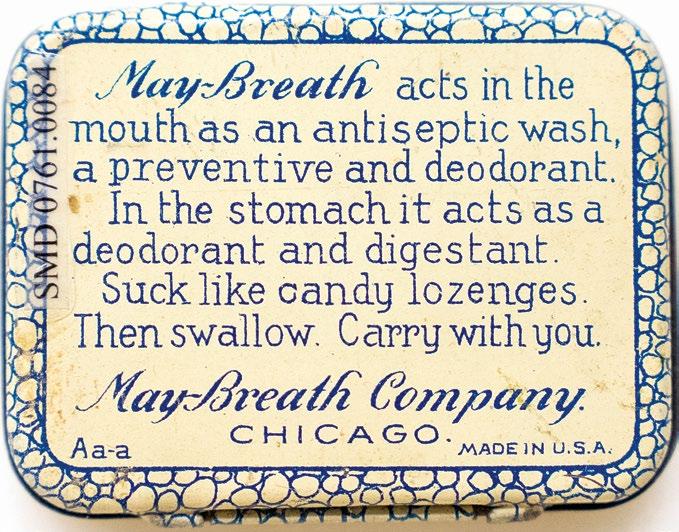
wash in tablet form; a scientific purifier, not a mere perfume that cries out your effort at concealment.” The ads declare that nearly every person has bad breath. “Smoking causes bad breath. So do stomach disorders. Certain foods and drinks are constant offenders. Or it may be food decaying between the teeth, or an unnoticed gum disorder.”
In an early example of companies offering free samples, readers who sent in a coupon would be mailed a free tin of tablets – retail value: 15 cents. “Instantly your breath is purified, made fresh and sweet as the Maytime,” the ad says, but neither the label of the tin box nor the ads list the ingredients capable of accomplishing that magical feat.
To see more of the Sindecuse Museum collections, go to www.sindecusemuseum.org/collectionsoverview
M Dentistry | Spring 2023 SCHOOL
Top Bottom
12
Dr. Purnima Kumar Named Fellow of AAAS
School of Dentistry faculty member and department chair Dr. Purnima Kumar was named a Fellow of the American Association for the Advancement of Science (AAAS) in January.
The science advocacy organization said Dr. Kumar received the prestigious honor for her distinguished contributions to the field of periodontology, particularly her studies of periodontal disease pathogenesis among people who smoke, including pregnant women, and for her research into inflammation around dental implants.

Dr. Kumar is the William and Mary K. Najjar Professor of Dentistry and chair of the Department of Periodontics and Oral Medicine. She is a dual-trained periodontist and microbial ecologist whose research investigates the myriad ways in which the
human microbiome can be harnessed to promote health.
AAAS is the world’s largest multidisciplinary scientific society and a leading publisher of cutting-edge research through its Science family of journals. The organization has more than 120,000 members in about 90 countries. Since 1874, its council annually selects Fellows from among scientists, engineers and innovators for their achievements across disciplines, in research, teaching, technology, administration in academia, industry, and communicating and interpreting science to the public.
Dr. Kumar has authored or contributed to numerous scientific papers investigating the oral microbiome and she serves as associate editor of several journals related to periodontology and microbiology. Several national institutes have provided funding for her work. Her research into how smoking and
vaping affect oral health has drawn national attention. In 2019, the American Dental Association appointed her as a spokesperson for media inquiries related to the growing use of vaping and its impact on oral health. She is regularly quoted in national publications and online news reports on the subject, and she provided a deposition to the U.S. Food and Drug Administration on the adverse oral effects of vaping.
Dr. Kumar is active in numerous national dental and scientific research organizations, including positions of leadership. Later this year, she will become chairperson of the ADA’s Council for Scientific Affairs, and she will also chair the Periodontal Research Group of the International Association of Dental Research (IADR). In March, she began a term as representative of the American Association for Dental, Oral and Craniofacial Research (AADOCR) on the joint IADR/AADOCR Publications Committee.
Associate Dean Dr. Lynn Johnson Retires
Lynn Johnson, Associate Dean for Faculty Affairs and Institutional Effectiveness and a professor in the Department of Periodontics and Oral Medicine, retired at the end of 2022.

Johnson joined the school in 2002 and managed wideranging responsibilities during her 20-year tenure. She led recruiting, appointments, promotions and other components of faculty affairs; she directed the school’s strategic planning process; and she oversaw the Dental Informatics office, which maintains the school’s information technology systems.
Johnson holds a PhD in instructional design and technology and is a nationally recognized leader in adapting the latest technology to advance dental education. Responding to a student request in 2004 for video recordings of lectures, Johnson worked with a team of students to investigate the optimal on-line delivery method for lectures. Her work led to the school being selected by Apple, Inc. as one of six institutions to pilot iTunesU, which was the initial stage of Lecture Capture technology that became a common tool for students at universities worldwide.
The school’s Dental Hygiene program used Johnson’s expertise and leadership in setting up its online degree completion and graduate programs in 2008 and 2012, respectively. In what became a national model, Johnson researched campus resources, assisted with strategic planning for the new programs and ensured technical support staff was in place to meet program needs. She also led improvements to the dental school’s electronic health records and collaborated with the U-M schools of medicine, nursing and public health to develop the educational program for a new dental school at a university in Ghana.
In 2019, the American Dental Education Association presented its prestigious Gies Award to Johnson in the category of Innovation for Dental Educators.
FACULTY
13 FACULTY Spring 2023 | M Dentistry
Faculty Pro f ile
Dr. Elizabeth Hatfield: All in on the quest to treat orofacial pain and TMD
Diagnosing and treating patients with widely varying symptoms of orofacial pain and temporomandibular joint disorder is a continual challenge that appeals to Dr. Liz Hatfield.
Many of her patients have experienced chronic pain for decades, so finding an effective treatment is immensely rewarding. On a broader level, she is contributing in numerous other ways to this field because of the educational role she leads on a daily basis.
Hatfield is a clinical assistant professor in the Department of Oral and Maxillofacial Surgery/Hospital Dentistry and is Director of the Temporomandibular Joint Disorder (TMD) and Orofacial Pain Residency Program. She leads residents through a clinical care and seminar program that includes Neurology, Headache and Neuropathic Pain, Pediatric and Adult Rheumatology, Physical Medicine and Rehabilitation, Movement Disorder, Otolaryngology, Anesthesia Pain, Sleep Medicine, and Oral and Maxillofacial Surgery. She also teaches at the dental school.
The two-year residency program is relatively new. Hatfield was the first resident, receiving her certificate in 2020, the same year the American Dental Association recognized orofacial pain (OFP) as the profession’s 12th specialty. Hatfield became interested in the field during her General Practice Residency (GPR) at U-M, which she finished in 2018 after earning her DDS from the U-M School of Dentistry in 2017.
During her GPR, a two-week OFP rotation with Dr. Lawrence Ashman drew Hatfield away from her general dentistry plans and into the OFP residency. The more she learned about how the body manifests pain and the difficulties of diagnosis in many cases, the more she was convinced that this was the kind of clinical care she wanted to pursue. The research project she did during her residency had the distinction of being the cover story in the December 2019 issue of the Journal of the American Dental Association. Hatfield was the lead author of a study reviewing medical literature on the efficacy of low

14 M Dentistry | Spring 2023 FACULTY
Dr. Elizabeth Hatfield in a corridor at the U-M hospital.
doses of naltrexone in the management of chronic pain conditions, particularly orofacial pain.
The title of a Continuing Education course she has presented in recent years summarizes the challenge for the OFP clinician: “My Face Hurts, Can You Help Me? Diagnosis and Management of TMD & Orofacial Pain.”
OFP is pain that is perceived in the face or oral cavity and caused from diseases or disorders there, though the pain can sometimes be caused by more-distant parts of the body. It can also be dysfunction of the nervous system, and often OFP is related to disorders of the hinge-like temporomandibular joint (TMJ) and related muscles that connects a person’s lower jaw to their skull. Treatment is wideranging, from physical therapy, bite splints and other oral appliances, medication and injections all the way up to complex surgery including TMJ replacement.
Hatfield said the U-M residency program emphasizes non-surgical management, starting with conservative treatment options and minimally invasive procedures rather than going too quickly to surgical options. Hatfield and two oral and maxillofacial surgeons, Drs. Mohamed Hakim and Ron Aronovich, have been collaborating on new protocols for the best ways to transition patients from their initial treatment to minimally invasive surgery and back to their OFP clinician. It’s an effort to do a better job of focusing on what fits each patient best.
The U-M OFP clinicians tend to see patients who have “chronic refractory pain that has been there for years and years and years,” Hatfield said. Planning treatment involves a lot of listening to patients explain their pain, its origins, how it has changed and many other “little puzzle pieces.”
“The thing that is tough about pain is that it’s not visible,” Hatfield said. She recalls one patient with longstanding headaches who was frustrated because well-meaning friends and relatives would regularly ask how she was feeling. “It gets old telling people I hurt everyday,” the patient told Hatfield. “People don’t want to hear that because nothing looks wrong with you. You’re sitting there and you look fine and you are at dinner with everyone, so you must be OK.”
As if being in constant physical pain isn’t bad enough, patients often experience emotional pain as well when family and friends are insensitive about their condition. That sort of stigmatization is common, Hatfield said. She recalls counseling a patient with severe muscular pain who was distraught because her life partner was unsympathetic and it was causing their relationship to fall apart. Once an effective treatment was found in Botox injections, which significantly reduced the pain, the patient’s attitude and outlook were transformed. “Now, when she came back for follow-ups, her pain is under control, she is happy, they are happy, she has her life back,” Hatfield said. “Every time I get to see her, it makes my day.”

Medication management is important in the field as is coordinating interdisciplinary care with healthcare colleagues in areas such as neurology, rheumatology, physical therapy, behavioral management
and oral surgery. “Oftentimes, it’s a multi-modal treatment that we have to come at from different angles,” she says.
Beyond her satisfaction in treating patients and leading the educational program for residents, Hatfield said another important aspect of her job is looking at big-picture ways to strengthen the relatively new dental specialty of OFP, not only at U-M but on a broader national and world level. One way she does that is in helping organize a national online Continuing Education course called Interprofessional Case Studies in Headache and Orofacial Pain. Originally started by Tufts University, the course is held via Zoom four to six times a year, usually on Saturdays. It draws from 350-500 OFP residents, faculty and clinicians, mostly from around the country but some log in from around the world. The sessions are designed for residents to present case studies and research, with discussion from leading experts and class participants. The idea is to efficiently spread evidence-based research and experience to a wider audience of OFP providers, as well as the general dental and medical communities, to enhance interprofessional understanding and collaboration for the specialty.
“I like academics because there is a big opportunity for educating our next generation and making an impact in terms of patient care,” Hatfield said. “We’re in a great space at Michigan for establishing this as a center for excellence in orofacial pain. That’s what I really want to do through resident education and with clinical faculty who are interdisciplinary, is to contribute meaningfully to evidence-based research. I think this is the right environment for it.”
“There is a lot of non-evidence-based orofacial pain care happening in the state, in the country, in the world. Patients suffer because of it because they don’t know the questions to ask. It is the thing that keeps me up at night. So we try to advocate and meet patients where they are at. I love the individual patient care, but thinking about it on a bigger scale is really important. Making sure that we are not taking advantage of a vulnerable population, that we are trying to provide better access, and part of that is the resident education. That’s the goal, the big picture, and that is really exciting.”
15 FACULTY Spring 2023 | M Dentistry
Hatfield leads a discussion related to management of temporomandibular disorders in a class attended by residents of the orthodontics graduate program at the School of Dentistry.
Faculty Notes
Dr. Stephen Meraw, Adjunct Clinical Professor of Dentistry in the Department of Periodontics and Oral Medicine, was appointed President-elect of the American Academy of Periodontology (AAP) during its annual meeting in Phoenix, Arizona, last fall. Meraw has taught at the School of Dentistry since 1999. An active member of organized dentistry, Meraw has served in many leadership positions, including President of the Michigan Periodontal Association, Trustee of the AAP, and Trustee of the Michigan Dental Association.
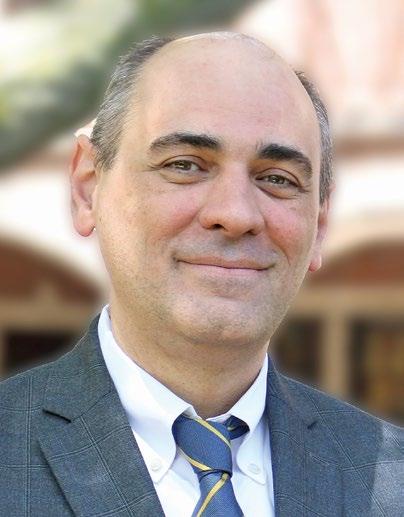
Dr. Nicholas Shirey, an Adjunct Clinical Assistant Professor in Orthodontics, received the 2023 Thomas M. Graber Award of Special Merit from the American Association of Orthodontists at the organization’s annual session in Chicago in April. The award is given to a first research paper of merit related to orthodontics by an orthodontic resident. Dr. Shirey presented a lecture on his research, “Comparison of Mechanical Properties of 3-D Printed and Thermoformed Orthodontic Aligners.” This award has been given by the AAO since 1971 and was named for Dr. Thomas Graber in 2002. Shirey earned his DMD degree from the University of Pittsburgh School of Dental Medicine in 2015, then served in the U.S. Navy Dental Corp. in Norfolk, Virginia, for four years. He completed his orthodontic residency at U-M in 2022, joined a private practice in Plymouth and is teaching part-time at the U-M dental school.


Faculty development and learning is the focus of a new project at the School of Dentistry that has received a grant from the University of Michigan Center for Academic Innovation (AI). The project is led by Vidya Ramaswamy, director of evaluation and promotion of teaching and learning at the dental school. She plans to use a learning management system called GradeCraft to offer faculty development opportunities, including those dedicated to course design, inclusive teaching and assessment. The project will bring a more coordinated approach to the school’s faculty development offerings and provide new incentives for faculty to adopt innovative teaching methods. Ramaswamy’s team includes Christopher Mong, the educational technology lead for Dental Informatics at the dental school, and Charlene Erickson, an academic program specialist. Ramaswamy hopes the project could serve as a model for other schools on campus and dental schools nationally.

Several faculty members have received awards this year from the Michigan Section of the Pierre Fauchard Academy:

Dr. Rogerio Castilho, associate professor of dentistry in the Department of Periodontics and Oral Medicine (POM), received the academy’s Special Appreciation Award, which honors dental faculty for outstanding contributions to dentistry and service to the profession. Castilho served as the interim chair of POM and was associate chair for several years. He joined the dental school in 2010 as an assistant professor trained in cellular and molecular biology at the National Institute of Dental and Craniofacial Research. He also holds a doctorate in cancer biology from the University of Sao Paulo, Brazil. A noted researcher, he has lectured both in the United States and throughout the world on oral wound healing and head and neck cancer. He uses an evidence-based approach to teach undergraduate and graduate students oral diagnosis and oral pathology. Castilho was also involved in creating and directing the first Massive Open Online Course (MOOC) from the School of Dentistry.
University of Michigan Provost and Executive Vice President for Academic Affairs Dr. Laurie McCauley, former dean of the School of Dentistry, received the Distinguished Dentist Award, given to fellows of the Fauchard Academy who exemplify the highest standards of honorary dental service to the academy, the community, academia and-or philanthropy. She is the William K. and Mary Anne Najjar Professor of Periodontics in the dental school and professor of pathology in the Medical School. She served as dean of the School of Dentistry from 2013-2022. An active researcher supported by the National Institutes of Health for more than 25 years, McCauley’s work focuses on parathyroid hormone anabolic actions in bone, immune cell functions in bone, and prostate cancer skeletal metastasis.
Dr. Romesh Nalliah, Associate Dean for Patient Services, was one of four new Fellows of the Academy inducted in February. Fellows are honored for their service to the dental profession as leaders and mentors.
Pierre Fauchard Academy is an international dental honorary organization that recognizes leaders and future leaders in dentistry. It was founded in 1936 in Minnesota and named for Pierre Fauchard of France, recognized as the father of modern dentistry.
 Dr. Stephen Meraw
Vidya Ramaswamy
Dr. Nicholas Shirey
Dr. Rogerio Castilho
Dr. Laurie McCauley
Dr. Stephen Meraw
Vidya Ramaswamy
Dr. Nicholas Shirey
Dr. Rogerio Castilho
Dr. Laurie McCauley
16 M Dentistry | Spring 2023 FACULTY
Dr. Romesh Nalliah
Dr. Peter Ma Paper Receives Award for Most Citations
A research paper published by faculty member Dr. Peter Ma was honored last fall as the mostcited paper in the 50-year history of an international journal of the Biomedical Engineering Society (BMES).

The paper, “Polymeric Scaffolds for Bone Tissue Engineering,” was published in 2004 in the journal, Annals of Biomedical Engineering. In celebrating the 50th year of publishing scientific research, Annals editors determined that Ma’s paper had more citations than any of the nearly 6,500 papers that the journal has published since its inception. Ma received the award during the annual meeting of the BMES in San Antonio, Texas.
When a paper is cited by successive researchers, it is often recognized as an indication of the importance of the original research.
Ma said the Annals’ editors at the time asked him to write about new bone tissue engineering research being conducted by his Polymeric Biomaterials and Tissue Engineering Laboratory at the School of Dentistry. Ma put together the outline to include the new research as well as summarize advances that scientists had made in recent years in the then relatively new field of using polymeric scaffolds to grow soft- and hard-tissue in the body. Ma was the corresponding author of the paper and one of his post-doc researchers at the time, Xiaohua Liu, was first author. Liu is now a professor at the Texas A&M University School of Dentistry. Liu drafted the paper and Liu and
Ma revised it numerous times before it was submitted, accepted and published by the Annals.
“When I started here, there was no kind of general understanding of what should be a good scaffold because we were in the process of creating them – different structures, different ways to design them,” Ma said. “So in the paper we generally laid out what might be good, what we were achieving and what we didn’t know then. It had a good summary structure to it, so people read it, people liked it, they felt they learned a lot.”
“As the Principal Investigator of the lab and the corresponding author of the paper, I received the award, but this is truly a recognition of all those who worked in our lab over the years,” Ma said.
Ma is the Richard H. Kingery Endowed Collegiate Professor in the Department of Biologic and Materials Sciences & Prosthodontics at the dental school, with appointments in biomedical engineering, macromolecular science and materials science at the U-M College of Engineering.
Three faculty members were inducted into the American College of Dentists last fall – from left, Dr. Todd Ester, Associate Dean for Diversity, Equity and Inclusion; Dr. Carlos González-Cabezas, Associate Dean for Academic Affairs; and Dr. Romesh Nalliah, Associate Dean for Patient Services. The national honor society for the dental profession was founded in 1920 and is the oldest major honorary organization for dentists. Membership is by invitation only after candidates are nominated. Fellows must demonstrate leadership excellence and are selected based on their exceptional contributions to organized dentistry, oral health care, dental research, dental education, the profession, and society. The approximately 7,000 Fellows in the ACD represent 3.5 percent of dentists.
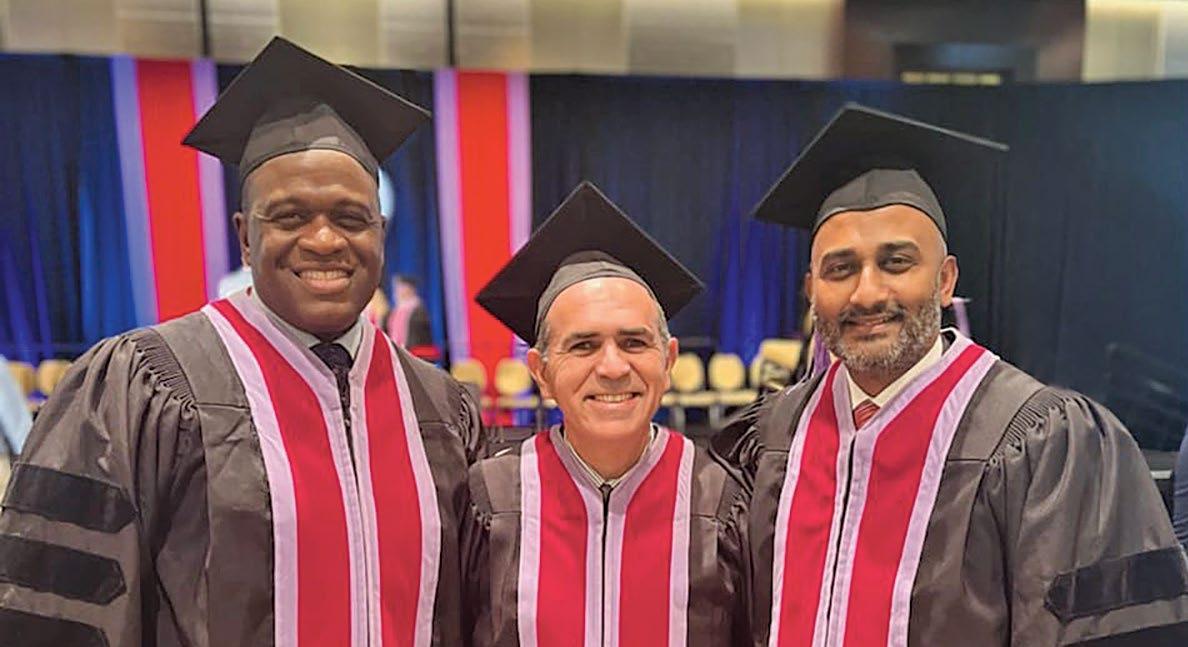
17 Spring 2023 | M Dentistry FACULTY
Diagnosis and Treatment Planning Textbook Updated
Dr. Stephen Stefanac, professor emeritus from the Department of Periodontics and Oral Medicine, has co-authored a new dentistry textbook with a familiar title. It’s the fourth edition of a book initially published in 2001 – “Diagnosis and Treatment Planning in Dentistry.”
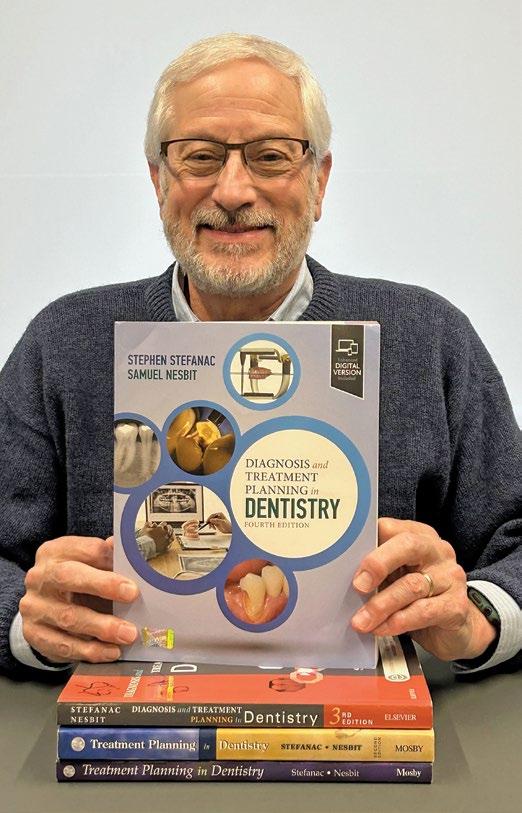
The book is used by dental schools across the United States and Canada, often in its electronic form, and by many dental schools in other countries.
After two years of a major rewrite, the Elsevier publishing company has released the new edition with revisions and updates for each chapter in the previous edition. A new chapter on “Digital Tools for Diagnosis and Treatment Planning” was added. Three new instructional videos for interpreting panoramic and cone beam computed tomographic images are now accessible through the book’s enhanced digital version. Including videos done for previous editions, that makes a total of 19. The digital version also includes study questions that mirror the national board questions so that students can practice what they learned in each chapter.
For all four editions, Stefanac has worked with co-author Dr. Samuel Nesbit, clinical professor in the Department of Operative Dentistry
at the University of North Carolina School of Dentistry. For this fourth edition, the co-authors also used material from 44 contributors from around the country, including 10 of Stefanac’s U-M colleagues. The 485-page book is divided into four sections that cover an overview of patient examination and diagnosis; the treatment planning process; the five phases of the treatment plan; and planning treatment for unique patient populations.
Stefanac, who also served the dental school as Senior Associate Dean and Associate Dean for Patient Services, continues to teach at the school on a limited basis. The book is an extension of that teaching. He said it is rewarding to be able to create and update a well-organized summary of the considerable breadth of dental educational experience he accumulated over the course of his career as a faculty member.
“I’ve been teaching since 1987, at Detroit Mercy, the University of Iowa and now here at Michigan. It's been a fun and challenging process to collect not only what I know, but also the expertise of others. I am grateful to have worked with so many knowledgeable contributors and to have such a great co-author. I think the fourth edition has turned out really well and I hope others agree.”
Adjunct Writes Book on Atraumatic Extractions
Dr. William Mason, Adjunct Clinical Assistant Professor of Dentistry, has authored his first book, “The Dentist’s Guide to Atraumatic Extractions.”
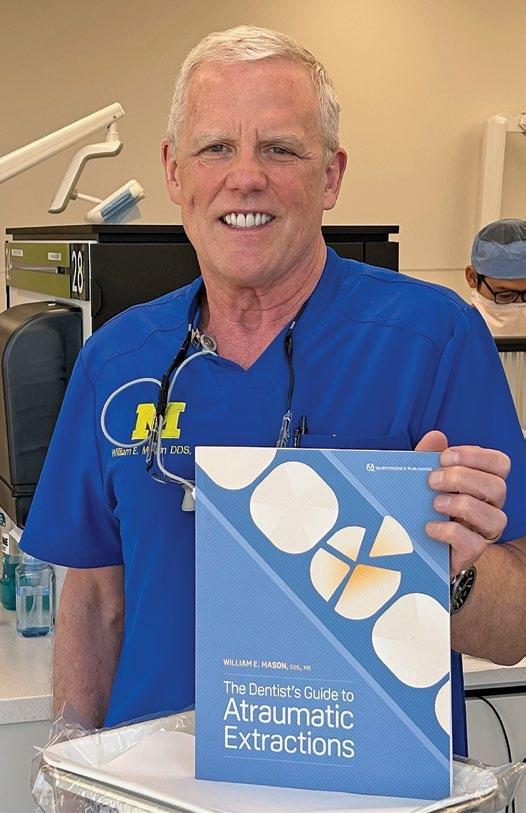
Mason, a periodontist who practices in Saginaw, Michigan, is a member of the Dean’s Faculty. An alumnus of the school (DDS 1981, MS perio 1984), he’s been an adjunct for about 20 years, teaching monthly in the Graduate Periodontics Clinic.
Mason said the book grew out of what originally was going to be only a magazine article for the Journal of the Michigan Dental Association. As he wrote the piece, he realized he had a lot of material and to do it justice, he should write a book. “This is not really a textbook,” he said. “It is more like a how-to book for a general dentist or a periodontist who wants to take out teeth carefully.”
Illustrated with dozens of photographs that Mason took in his office, the book took two years to complete. Mason recounts how the advent of dental implants in the late 1980s prompted the need for improvement in tooth extraction methods. Traditional methods of raising flaps and luxating the tooth to force it out of the bone often results in significant trauma and ridge resorption, which can compromise implant placement. His atraumatic extraction technique, or AET, relies on systematic removal of root structure to protect the socket from deformation and thereby maintain the patient’s original jaw anatomy and facial structure. Root structure is removed to allow space for the remaining tooth structure to be maneuvered and manipulated instead of pushed into the adjacent bony walls, thereby protecting the bone from trauma and resorption.
“Let me be clear that I do not have a big secret or magic bullet for atraumatic extraction,” Mason writes in the book. “Instead I have curated many small secrets and tips that together result in a very comfortable, atraumatic, and ridge-preserving experience for the extraction patient.”
The book is published by Quintessence Publishing.
M Dentistry | Spring 2023 FACULTY 18
RESEARCH Research Day
School’s annual event sets poster record
An incredible variety of scientific research projects and a record number of posters – 126 –energized the annual Research Day on Feb. 16 at the School of Dentistry and the Michigan League. The event celebrates the quest for scientific knowledge by students, postdoctoral trainees, staff and faculty members in the research labs and clinics at the school.
Keynote speaker Nisha D’Silva, BDS, MSD, PhD, a faculty member at the School of Dentistry, provided an update on the latest oral cancer research conducted by her lab, including some so new that she hadn’t presented it before. She focused on findings in how cancer cells interact with nerves, a process called perineural invasion, as she discussed research into oral cancer, the sixth most common cancer. By better understanding perineural invasion, it may allow a different and more accurate indicator relating to the stage of a patient’s cancer, which can inform treatment decisions that could lead to better outcomes than current methods.
Top award recipients included:
• Andrew Chen, a third-year dental student, received the SCADA Award (Student Competition for Advancing Dental Research and its Application) for his research, “Calcium release to culture media as an indicator of mineral loss in biofilm models to study caries.” Faculty mentor: Dr. Livia Tenuta. The SCADA award is sponsored by the American
Association for Dental, Oral, and Craniofacial Research (AADOCR) and Dentsply Sirona, a dental supply company. Chen will represent the school and present his research at the annual meeting and exhibition of the AADOCR in New Orleans, Louisiana, in March 2024.

• Caroline Anselmi, a visiting PhD student, received the AADOCR Travel Award for attending the 2023 IADR/AADOCR annual meeting and exhibition in Portland, Oregon, in March, where she will present her research: “Immunomodulation of LPS-challenged human dental pulp cells by quercetin for vital pulp therapy.” Faculty mentor: Dr. Marco Bottino.
Felicia Miranda, a post-doctoral fellow in orthodontics, explains her research project, “Three-dimensional effects of maxillary protraction anchored in miniscrews versus miniplates,” to faculty member Carlos González-Cabezas, associate dean for academic affairs.

Category 1: Clinical Research and Public Health
• 1st Place among DDS, Hygiene, Masters and Undergrad students – Marwa Aggour and Zeinab Aladily, fourth-year Dental Hygiene students. Research Title: “Interprofessional Integration of Oral Health in the Nurse Practitioner Curriculum.” Faculty mentor: Stefanie VanDuine
• 1st Place among PhD Students (DDS/PhD), Postdoctoral Trainees and Staff – Amanda Rodriguez Betancourt, a research fellow in the Department of Periodontics and Oral Medicine. Research Title: “Ultrasoundbased Jawbone Surface Quality Evaluation for Planning of Dental Implant Surgeries.” Faculty mentor: Hsun-Liang Chan
Category 2: Basic Science Research and Translational Science
• 1st Place among DDS, Hygiene, Masters and Undergrad students – Andrew Chen, a thirdyear dental student. Research Title: “Calcium release to culture media as an indicator of mineral loss in biofilm models to study caries.”
Faculty mentor: Dr. Livia Tenuta
Spring 2023 | M Dentistry 19 RESEARCH
Andrew Chen
Continued
• 1st Place among PhD Students (DDS/PhD) and Postdoctoral Trainees and Staff – Hülya Taner, a dual DDS-PhD student. Research Title: “Sox2-driven Epithelial Transformation Promotes IL1-mediated Peripheral Immune Tolerance.” Faculty mentor: Yu Leo Lei.
Dental Hygiene Awards
• 1st Place Original Research Award – Haley Harland, Shams Albadry and Alisson Castro Garcia, fourth-year Dental Hygiene students. Research Title: “Stress Management Techniques for Dental Hygiene Students.” Faculty Advisor: Stefanie VanDuine.
Other Research Day awards
• The Janice E. Berry Prize for Excellence in Research was presented to Hiroki Ueharu, a postdoctoral fellow in the Yuji Mishina lab in the Department of Biologic and Materials Sciences & Prosthodontics. The family of Berry, a longtime U-M and dental school


staff member who died in 2016, created the $1,000 award, also known as Jan’s Prize, to recognize a full-time researcher who may be currently experiencing a financial hardship.
• Dr. Nisha D’Silva, the Donald Kerr Endowed Collegiate Professor at the School of Dentistry, received the Distinguished Faculty Mentoring Award. It recognizes faculty who consistently impart their research knowledge and experience with students and scholars in areas of clinical, basic science and-or translational research.
• Patrick Lagua, director of the Office of Research, received the Research Staff Recognition Award. The award recognizes individuals who, over a number of years, have aided in the advancement of the research mission of the school that extends beyond the normal fulfillment of the position’s duties.
More Research Day information is available on the Research section of the school website at https://dent.umich.edu/research.
SPONSORED RESEARCH AWARDS
>$50,000 from September 1, 2022, to March 31, 2023
NATIONAL INSTITUTES OF HEALTH AND OTHER FEDERAL AGENCIES
Dr. Marco Bottino: (R43) Matregenix/NIH, $85,670. Electrospun Amino Acid-based poly(ester urea) Biodegradable Barrier Membrane for Guided Bone Regeneration.
Dr. Justine Moe: (UG1) University of Arizona/NIH, $211,228. M4OC-Prevent
2.0: Phase IIb Trial of Metformin for Oral Cancer Prevention.
Drs. Joshua Emrick (PI) with Daiwen Cai (Cell & Developmental Biology): (UC2): Duke University/NIH, $356,099. Neural Architecture of the Murine and Human Temporomandibular Joint.
Drs. Tian Liang (PI), with James Simmer, Jan Hu: (K99) NIH, $203,178. Ameloblastspecific mineral ribbon attachment/elongation complex in enamel formation.
Dr. Hajime Sasaki: (R56) NIH, $402,000. Functional role of serum Amyloid A in periapical inflammation.
Christina Jones with Dr. Isabelle Lombaert: (F30) NIH, $210,208. Determining Sox10-mediated plasticity in irradiated salivary gland cells.
Dr. Margherita Fontana with Dr. Livia Tenuta, Emily Yanca, Dr. Erika Benavides, Dr. Sarah Stoddard (Nursing), Dr. Gary Freed (Pediatrics), Dr. Susan Woolford (Pediatrics): (U01) NIH, $8,617,785. Predicting Caries Lesion Patterns and Trajectories in Underserved Children, from Infancy to Early Adolescence, in Primary Healthcare Settings.
FOUNDATIONS, INDUSTRY and OTHER AWARDS
Dr. Dennis Fasbinder: Dentsply Sirona, Inc, $110,521. Clinical Evaluation of Implants Restored with Advanced Lithium Disilicate Screw-Retained Crowns (Tessera Screw Retained Crowns).
Dr. Purnima Kumar: The Ohio State/ Wrigley, $181,250. Wrigley Translational Study.
Drs. Justine Moe (PI), Brent Ward, Jacques Nör, Peter Polverini: Oral and Maxillofacial Surgery Foundation, $75,000. Estrogen Receptor Signaling in Oral Squamous Cell Carcinoma.
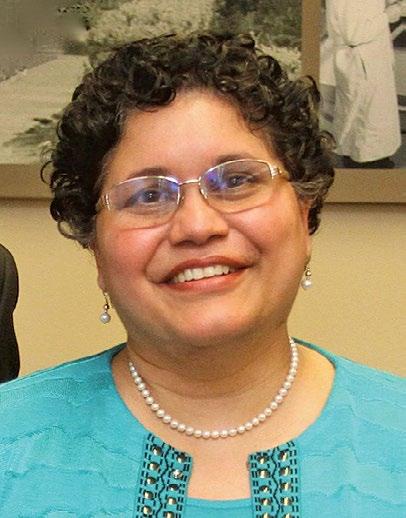
RESEARCH M Dentistry | Spring 2023 20
Research Day (Continued)
Dr. Nisha D'Silva Patrick Lagua Hiroki Ueharu
Research Notes
Dr. Joshua Emrick, an assistant professor of dentistry in the Department of Biologic and Materials Sciences & Prosthodontics, is among researchers joining an important National Institutes of Health initiative focused on improving prevention and treatment strategies for opioid addiction, and enhancing pain management. The Restoring Joint Health and Function to Reduce Pain Consortium, or RE-JOIN, consists of five research teams working together to map the network of sensory nerves that connect to joints. Researchers will create 3-D maps of the different types of sensory neurons focusing on two joints: the temporomandibular joint and the knee. The work aims to discover which neurons influence and trigger pain. Emrick is one of three Principal Investigators on a team led by Christopher Donnelly, an assistant professor at the Duke University School of Medicine. Donnelly earned his dual DDS-PhD degrees at the U-M dental school in 2018. The team’s third PI is Dawen Cai, an associate professor at the U-M Medical School. The team received a $5.7 million grant for three years, with a likely two-year extension and additional funding, for its project, “Neural Anatomy of the Murine and Human Temporomandibular Joint.” It will define the properties of sensory neurons that innervate tissues which form the TMJ.
Hülya Taner, a dual DDS-PhD student at the School of Dentistry, received an award for her scientific research in head and neck cancer at a national conference last November. Taner received one of five awards presented in the Basic and Translational Research category at the 27th annual Hinman Student Research Symposium in Memphis, Tennessee. Sponsored by the University of Tennessee College of Dentistry and the Hinman Dental Society, the symposium featured oral and poster presentations of research projects by 101 dental students and graduate trainees from 46 dental schools in 30 states, the District of Columbia, Puerto Rico and a province of Canada. Taner’s research presentation was for the project,


“IL-1a-Mediated
Suppressive
Myeloid Function in the Initiation of Head and Neck Cancers.” Oral cancers arise in potentially pre-malignant precursor lesions, known as epithelial dysplasia. Although oral cancers have been well known to be invisible to the surveilling immune system, it is unclear how initiating cancers reach that point of no return. This research found that a subset of epithelial dysplasia expresses an oncogene, SOX2, which helps to recruit a group of
annually by the Department of Biologic and Materials Sciences & Prosthodontics to honor an outstanding student researcher. The annual award was established in 1989 in memory of Dziewiatkowski, who was known as “Dr. Jay.” He chaired the Department of Oral Biology and directed the Dental Research Institute from 1967-1972. The award was presented to Gannot by Dr. Jay’s daughter, Jane Damren. Gannot, who started the PhD program in 2019, is working in Dr. Peng Li’s lab, which studies the molecular and cellular mechanism underlying breathing. Gannot’s research focuses on the neuronal circuit that controls coughing, a common symptom of many diseases. Through a molecular and functional screen in the mouse brain, the Li Lab has identified the first genetically defined neuronal population in the brain that mediates coughing. Tracing from this population, Gannot is hoping to find the neural circuit for coughing. Gannot received her undergraduate degree from the University of Maryland, College Park, where she studied Bioengineering and French Studies. Before coming to U-M, she was a postbaccalaureate at the National Institute of Mental Health.
immune cells that suppress productive anti-tumor immunity and cause smoldering inflammation at the lesional site. This key event establishes immune tolerance to encourage the tumors to initiate. Targeting this pathway can delay the onset of oral cancers, which offers a potentially new approach for oral cancer prevention in high-risk individuals. Taner’s research is under the direction of dental school faculty member Dr. Yu Leo Lei, Associate Professor in the Department of Periodontics and Oral Medicine.
Noam Gannot, an Oral Health Sciences PhD student, received the 2022 Dr. Dominic Dziewiatkowski Award last fall. It is given

Ben Swanson, a dual DDS/PhD student in the Oral Health Science program, received second place in the Basic and Translational Science Category of the 2023 SCADA (Student Competition for Advancing Dental Research and its Application) at the 2023 annual meeting of the American Association for Dental, Oral, and Craniofacial Research. His project: Scaffold-based Approach to Regenerating the Cranial Suture Stem Cell Niche. Candidates presented their research in a closed session to a panel of judges and publicly in a poster session at the meeting. Also at the conference, Student Research Fellowships were presented to PhD students Erica Siismets, Alexandra Herzog and Ben Swanson, and D2 Yanjie Huang and D3 Tommy Lau. PhD students Alexandra Herzog and Marsha-Kay Hutchinson each received a Bloc Travel Grant.

Spring 2023 | M Dentistry RESEARCH 21
Dr. Joshua Emrick
Hülya Taner
Noam Gannot
Ben Swanson
DH Students Back in Area Schools for ‘Smiles’ Program
More young children around Washtenaw County are getting a good start on oral healthcare thanks to an expansion of services in a community service outreach program that sends the school’s Dental Hygiene students to Head Start locations.
The Smiles For a Lifetime Program is gearing up again after the pandemic limited the school visits over the last two years. The program is administered through the Michigan Department of Health and Human Services in collaboration with the Washtenaw Intermediate School District. The Public
Dental Prevention Program, known as P.A. 161, certifies non-profits to organize dental hygienists to administer preventative services to those most in need of oral healthcare.
The hygiene program at the School of Dentistry took over the program in 2016 and initially sent hygiene students to five Head Start locations to apply fluoride varnish for students ages 3-5. Over time, the program has expanded to nine Head Start locations. Additional services now include the application of sealants at several of the Head Start locations where there are also students in

kindergarten and first- and second-grades, in the 6-8 age group at which sealants are recommended.
The nine locations are located in Ypsilanti, Ann Arbor, Manchester, Whitmore Lake and
M Dentistry | Spring 2023 DENTAL HYGIENE 22
DENTAL
Above: Instructor Colleen Sorensen holds a flashlight to assist students Marwa Aggour (left) and Sumaia Al-Suraimi as they examine a student at an elementary school in Whitmore Lake as part of the Smiles For a Lifetime Program.
HYGIENE
Lincoln school districts. Parents must give permission for the treatments.
Darlene Jones, Interim Director of the Division of Dental Hygiene, said the program is an extremely valuable part of the DH curriculum. “There is so much value in the experience because the hygiene students see what it’s like to work in the community and they gain more experience in working with young children. In turn, the children learn about oral hygiene and see the dental hygiene profession in a positive light. If you have a kid who has a wonderful experience with our student in what may be the first time they’ve ever had their teeth examined, they will carry that positive experience with them for future dental visits. To me, it’s just a win-win all the way around.”
DH adjunct clinical instructor Colleen
Sorensen has supervised the program since January. In April, Sorensen and four DH students set up shop in an elementary classroom at a Whitmore Lake elementary school. Two elementary students at a time leaned back in portable reclining chairs next to a chalk board covered with colorful drawings of rocket ships, turtles and butterflies. Two dental hygiene students flanked each child to conduct an oral exam and apply sealants to the children’s molars. A portable air compressor whirred in the background as it supplied the power for the students’ dental instruments.
Sorensen stood nearby, answering her students’ questions and moving in to check their assessments of the kids’ teeth.
Most often, she takes six fourth-year students to the various schools to set up these portable clinics for fluoride varnish and-or sealant application. The program may expand to include cleanings for school-age children. Offering services in nursing homes is another idea that has been discussed. Sorensen said it is surprising how accepting the children usually are, particularly since a significant number have never seen a dentist before. “The kids love us,” she said. “They remember us from the time before. They give us hugs in the hallways. They get real excited. They also get to choose a sticker when we’re done, so it’s a fun time for them.”
DH Adds New Pathway to BS, MS Degrees
Dental hygienists with associate’s degrees who wish to further their education and career opportunities by obtaining bachelor’s and master’s degrees have a new option at the School of Dentistry.
The school’s Dental Hygiene division has created an innovative new online program that streamlines the time it takes to earn the BSDH and MSDH degrees without changing the current master’s program rigor or structure. The new pathway, called the Accelerated Online AS-MS in Dental Hygiene Program, will be available starting in Fall 2023.
The program integrates the 15-year-old online E-Learning Degree Completion Program with the existing MSDH degree program in a way that reduces the time needed to complete the BS and MS degrees separately, from four years to three years. Students complete their BS degree through a combination of undergraduate and graduate credits before applying to the MS program through the University of Michigan Rackham Graduate School, just as previous and current MSDH students have done.
DH faculty conducted an in-depth feasibility study using data from rigorous internal and external reviews. The plan was then reviewed and approved by the Rackham Graduate School.
DH faculty member
Jennifer Cullen, a Clinical Lecturer and Director of the Dental Hygiene Degree Completion Program, will direct the new program in collaboration with faculty member Dr. Danielle Rulli, a Clinical Associate Professor and Director of the MSDH program.
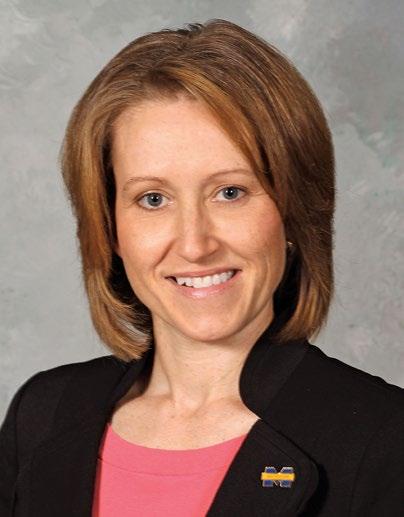
Darlene Jones, Interim Director of the Division of Dental Hygiene, and Martha McComas, Interim Associate Director, announced the program in April. They credited Cullen, Rulli and DH faculty member Janet Kinney, a Clinical Professor of Dentistry, for their “relentless efforts” in researching and designing the program. Dr. Purnima Kumar, Chair of the Department of Periodontics and Oral Medicine, which oversees the DH division, and Dr. Jan Hu, the dental school’s Interim Dean, were also instrumental in supporting the plan, Jones and McComas said.
Cullen said the AS-MS pathway is of benefit to hygienists who wish to expand their professional opportunities into academia, clinical and behavioral research, public
health, health administration, policy or management. Since the program is being offered online, practicing hygienists can continue in their current jobs and communities while earning the additional degrees that will allow for future professional advancement and increased earning power. By reducing the time commitment from four years to three, it not only speeds the process, but it also reduces costs for students.
“The expanding landscape of the dental hygiene discipline is creating demand for streamlined paths to graduate degrees, especially for the working professionals who make up the majority of our student population,” Cullen said. “Like our other online offerings, this program will support the mission of the School of Dentistry to provide innovative and engaged learning while advancing health through education, service and research.”
The on-campus degree completion program will still be an option for associate-prepared hygienists wishing to complete the BS degree only. The traditional two-year MS program (online or on campus) will also still be available to dental hygienists who already have their bachelor degree.
More information is available on the Dental Hygiene section of the School of Dentistry website at https://myumich/4rD3n.
Spring 2023 | M Dentistry 23 DENTAL HYGIENE
Jennifer Cullen
STUDENTS Class of 2023 Graduation
All in the Family
DDS parents who are alumni are invited to assist with the hooding of their children during commencement, and most years an assortment of moms and dads are involved. This year, however, all the alumni parents are dads. That quirk is interesting timing since the DDS Class of 2023 has the most women and highest percentage (about 60 percent) of any class in school history. This year’s students and their alumni fathers:




• Danielle Baratz – Dr. Robert Nakisher (DDS 1992)
• Laura Davenport – Dr. Steven Davenport (DDS 1997)
• Sara Heidenreich – Dr. David Heidenreich (DDS 1992)
• Parker Johnson – Dr. Marc Johnson (DDS 1988)
• Megan Makela – Dr. Mark Makela (DDS 1988)
• Rachel McGue – Dr. Jerry McGue (DDS 1990)
24 M Dentistry | Spring 2023 STUDENTS
1 2 4 6
1. DDS graduate Rachael McGue shares the moment with her father, Jerry, a 1990 alumnus of the school, after he helped with her hooding. At left is Dr. Renee Duff, Associate Dean of Students.
2. Dental Hygiene graduates, from left, Alexa Parker, Katrina Miskey, Jazmyn Ragland and Beth Al-Heleal join the postgraduation ritual of wading in the fountain on Ingalls Mall.
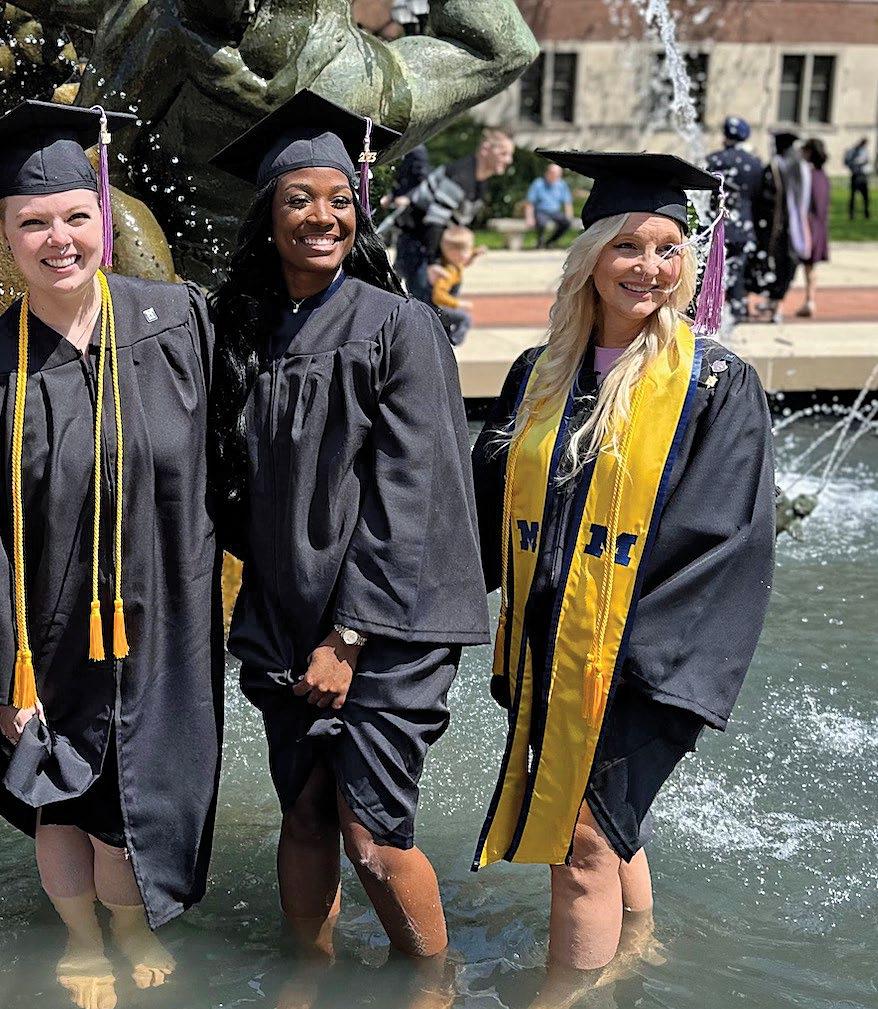
3. DDS graduate Sean Penoyer is hooded by Dr. Renee Duff and Dr. Don Heys.

4. As he crosses the stage, DDS grad Torrey Talifer stops to shake hands with faculty member Dr. Todd Ester, Assistant Dean for Diversity, Equity and Inclusion.
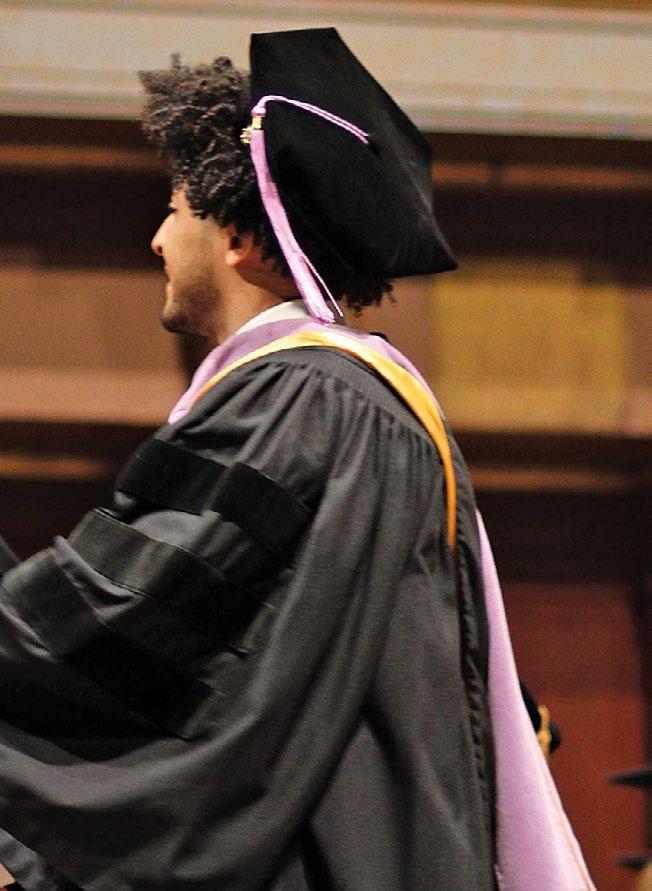

5. The parents of DDS grad Zahraa Ahmad offer a congratulatory double kiss.

6. A three-generation family of U-M dentistry grads celebrate: Dr. Edward Davenport (DDS 1963); new graduate Dr. Susie Davenport; and her dad Dr. Steven Davenport (DDS 1997), all of Jackson, Michigan.
7. After the ceremony on the steps of Hill Auditorium, DDS graduate Ezinne Nwadinobi poses for a photo with her parents, Johnkay and Evelyn.

Spring 2023 | M Dentistry 25 STUDENTS 7 5 3
Kids – and dental students – were all smiles at this clinic

A very large group picture took place at the conclusion of the 2023 “Give Kids a Smile” clinic, organized by students at the School of Dentistry in early April. About 125 volunteer dental students, dental hygiene students, faculty and staff performed basic treatments, such as exams, cleanings, x-rays, fluoride and silver diamine applications, sealants, fillings and an occasional extraction for children ages 4-14. Any serious problems that were discovered were referred for further treatment. The event drew more than 100 children and their families from around the Ann Arbor region. The community service clinic provides free dental exams, basic dental procedures and the opportunity to educate kids about the importance of brushing, flossing and going to the dentist regularly.
Dental Student Selected for Dow Sustainability Program
RayJ Jackson, a third-year dental student, is one of 33 professional and master’s students at the University of Michigan who have been selected as 2023 Dow Sustainability Fellows by the Graham Sustainability Institute.

The annual fellows program forms collaborative, interdisciplinary teams that participate in a variety of sustainability projects around the world. Dow Fellows work with businesses, non-profit organizations and communities in an effort to advance sustainable practices.
Leaders of the fellows program have assigned Jackson to a team that will work with the Ripples Foundation on a sustainable agriculture plan to enhance food security and economic independence for women in Ghana. Ripples is a non-profit founded in 2005 to focus on economic empowerment of women. About 70 percent of rural women in Nigeria, Ghana and Madagascar are below the poverty line
and illiterate. Ripples provides women with training and resources to run sustainable businesses that protect the environment.
In his application to the Dow program, Jackson cited his goals of providing increased access to healthcare for underserved communities in the context of sustainability, which is defined by the United Nations as “meeting the needs of the present without compromising the ability of future generations to meet their own needs.”
“My career goals stand as maximizing access, care, and dental health within underserved communities,” he wrote in the application. “I intend to continue working with, listening to, advocating for, and assisting these communities to achieve the goals of sustainability, circular economy and climate protection.”
Dr. Billy Scholarship Award Recipient
The 2022-23 Edward J. Billy Scholarship Award recipient is Dr. Saumya Kapoor, a resident in Graduate Prosthodontics who will finish the three-year program in 2025.

The Billy scholarship is named for a clinical professor of dentistry and director of Graduate Prosthodontics Program who came to the U-M dental school in 1992 as a lecturer and worked through the ranks to being named a clinical professor in 2001, retiring in 2006. Recipients of the Billy Scholarship must demonstrate excellence
and enthusiasm in clinical and laboratory phases of prosthodontics, and must have completed substantial laboratory work, such as the processing of dentures, fabrication of bite splints and surgical templates.
Kapoor was born and raised in Lucknow, India. She completed her Master of Dental Surgery (Prosthodontics) from Manipal University, India, and then worked as a senior resident at the Department of Prosthodontics, King George’s Medical University, also in India. She joined the U-M graduate program to further enhance her knowledge and skills in Prosthodontics, Digital Dentistry and Implantology. Her goal is to excel as a board-certified prosthodontist and share her knowledge and experience in global academic institutions.
M Dentistry | Spring 2023 STUDENTS 26
RayJ Jackson
Dr. Saumya Kapoor
ALUMNI Reunion Weekend
Emeritus DDS Class of 1972 Headlines School’s Annual Reunion Weekend
The School of Dentistry’s DDS Class of 1972 – and one master’s degree alumnus from that year – celebrated their 50th anniversary during the school’s annual Reunion Weekend last November.

Thirty members of the DDS class returned for a weekend of memories and reminiscing about their time at the dental school from 1968-72. Their four years at the school were split between the old dental school building and then a move to the current “new” building that was completed in 1971. Each class member was presented with a University of Michigan emeritus pin and personalized School of Dentistry emeritus medallion during a ceremony held at the Michigan League on Thursday morning. It was followed by a luncheon at which the school held its annual Hall of Honor induction and presentation of the Distinguished Service Award.
Interim Dean Jan Hu presented a summary of the school’s departments, recent developments and history for the alumni. “As we present our awards today – the Hall of Honor and the Distinguished Service Award – we acknowledge the high-achievers who make
this school truly special,” she said. “It is important for us as a School of Dentistry community to honor the legacy of our world-class enterprise that has been training dentists for 148 years. Our collective experiences make us strong – both as individuals and as a dental school. The high quality of our students and faculty throughout the history of this school is truly remarkable.”
“Every student and every professor who came through this school helped build and maintain the culture of excellence that continues to this day. That includes each of our alumni here today,” Hu told the alumni who returned for the weekend.
Hall of Honor Award
The Hall of Honor Award is presented posthumously by the school’s Alumni Society Board of Governors to recognize and honor individuals who have made outstanding contributions to the profession of dentistry. Nominees must be a graduate of the DDS, Dental Hygiene, MS or PhD programs, a faculty member or a research staff member. Since the Hall of Honor was created in 2003, 53 people have been honored with a plaque in a hallway at the school.
This year’s honoree is Dr. Gloria Kerry, who received her DDS in 1956 and her MS in periodontics in 1966. She was a trailblazer for women in dentistry and academia. She balanced practicing dentistry and raising a family with teaching, research and mentoring at the dental school during an era when women were rarely either dentists or professors.

After graduating with her DDS (one of only two women in the 1956 class), she practiced for several years with her father, a dentist in Detroit, then returned to the dental school for her master’s in periodontology. Her skills, experience and impressive research earned her an offer to join the faculty, but she declined because she was in the midst of raising five young children. In 1974, when all her children reached school-age, she returned as a faculty member and started a practice in Ann Arbor the following year. She continued to publish numerous studies and her credits include a prestigious Clinical Research Award from the American Academy of Periodontology for her role with Dr. Sigurd Ramfjord in a five-year study of surgical and non-surgical treatment of periodontal disease. She held numerous leadership positions in dentistry and other organizations, often as the first women to do so.
Dr. Kerry retired from the faculty in 1989, returned to her Ann Arbor practice full-time and continued to see her beloved patients until only a few weeks before her death in January 2019. Two of her children, daughters
27 Spring 2023 | M Dentistry ALUMNI
Mary Kay Baribeau takes a photo of her husband Dr. Doug Baribeau (left) and his classmate Richard Martzke during the DDS Class of 1972 emeritus ceremony. The two retired dentists are longtime friends dating to their days as high school students in Grand Ledge. Martzke lives in Grand Ledge and Baribeau lives in Port Huron.
Continued
Dr. Gloria Kerry
Karen and Julie (both U-M DDS 1985), and granddaughters Kelly and Taylor Chick (both U-M DDS 2022), followed Gloria into the profession of dentistry, extending the family tradition to four generations.
Dr. James McNamara, professor emeritus of orthodontics who was asked by Dr. Kerry’s family to speak at the induction, knew her for 40 years personally and professionally. McNamara said he often referred his patients to Kerry, particularly those with temporomandibular disorders, even though she was a periodontist. His last referral was only a few months before Kerry died, while she was still seeing patients in her late 80s. “I sent her a patient because I really felt that she was a person who could give me some insight into how this patient would be best treated,” he said.
McNamara also praised Kerry’s wide impact as a role model for women wanting to combine a professional career while raising a family. “She was a great motivator, even encouraging her dental hygienists and assistants to consider attending dental school themselves,” he noted.
Dr. Karen Kerry, who carries on the Kerry family practice in Ann Arbor with her two daughters, said her mother cared deeply about her patients, many of whom became her friends after years of treating them. “She loved dentistry. She lived and breathed dentistry,” Kerry said. “Our whole family is so super-proud of her. She ran the
periodontal practice as an extension of her family, her beautiful smile, warmth and compassion touching all those around her.”
Distinguished Service Award
The School of Dentistry Board of Governors Distinguished Service Award was created

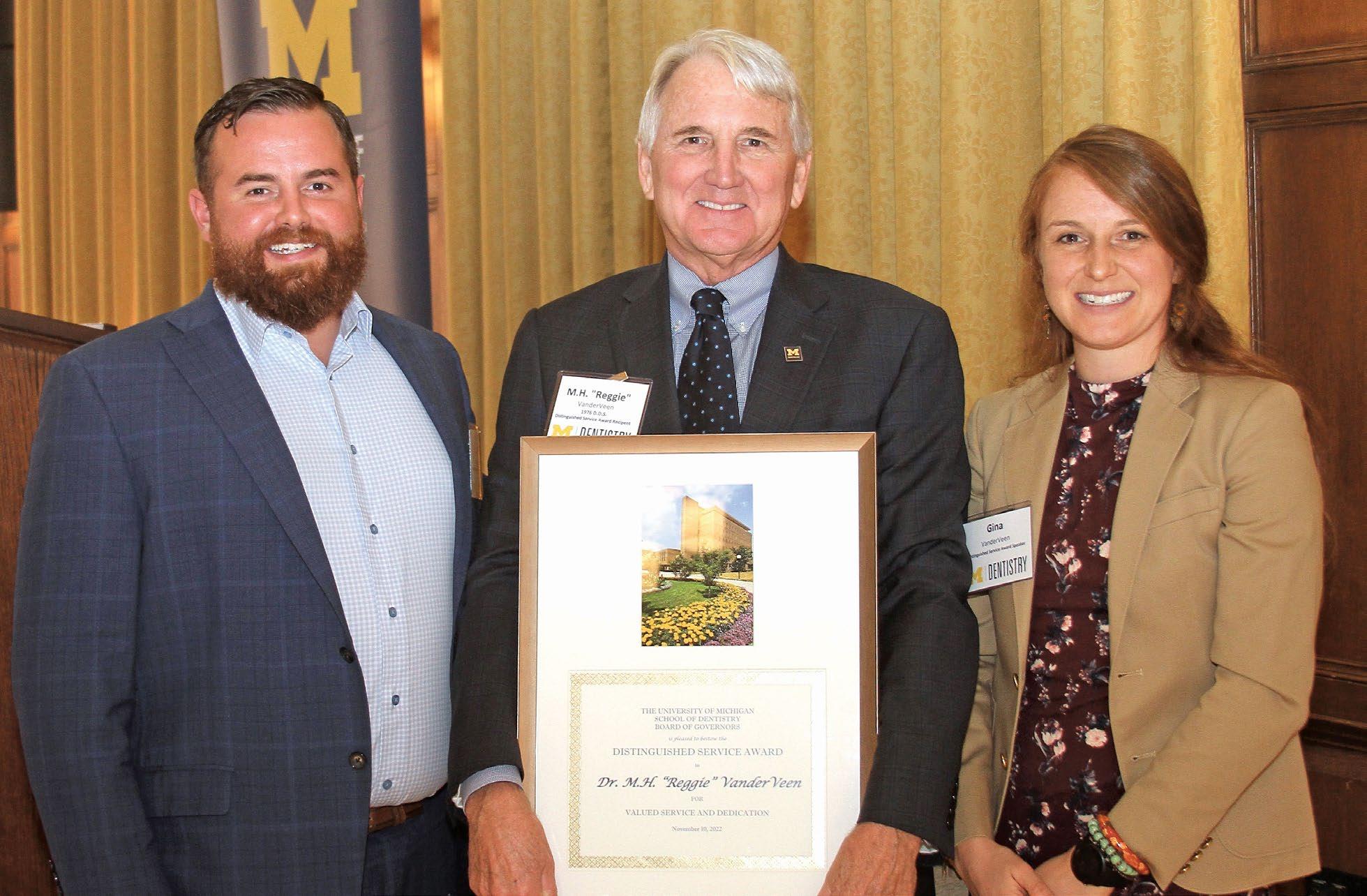
to give appropriate recognition and honor to individuals who have made outstanding contributions to the profession of dentistry. Nominees must be graduates of the school’s DDS, Dental Hygiene, Master’s or PhD programs; a faculty member; or a research staff member.
The 2022 recipient is M.H. “Reggie” VanderVeen of Grand Rapids, who earned his DDS at the School of Dentistry in 1976. It would be difficult to find a resume with more service to the profession of dentistry than the one that Dr. VanderVeen has lived out over the last 45 years. His resume is a lengthy list of activities and leadership positions for local, state and national dentistry organizations, with a particular emphasis in the areas of accreditation and professional ethics.
His service started early in his 30 years of practicing in the Grand Rapids area and continued after his retirement in 2008. Even in retirement, with some not-so-subtle prompting from his wife Gayle, he spent seven years as a consultant to Michigan dentists, offering up his career-acquired wisdom about buying and selling practices, practice management and retirement. His longstanding service commitment includes numerous Michigan Dental Association committees; four years on the Michigan State Board of Dentistry; American Dental Association commissions related to accreditation and examinations; the American Board of Dental Examiners (ADEX); the Northeast Regional Board of Dental Examiners; president and numerous other offices and committees for the West Michigan District Dental Society; membership in the American and International Colleges of Dentists; and community service for his church, Cub Scouts, the Kent
28 M Dentistry | Spring 2023 ALUMNI
Reunion Weekend (Continued)
Dr. Karen Kerry and Dr. James McNamara with a copy of the plaque celebrating the legacy of Gloria Kerry that will be displayed in the Hall of Honor near one of the entrances at the School of Dentistry.
Dr. Reggie VanderVeen with his children, Nick and Gina, who introduced him during the Distinguished Service Award presentation.
County Community AIDS Council, and as a founding member of Clinica Santa Maria, a Hispanic population dental clinic.
Reggie and Gayle have been loyal supporters of the School of Dentistry for many years, with both time and financial gifts. Reggie has served several terms on the school’s Alumni Society Board of Governors, as chair from 2013-14, and was a committee member for the school’s last two campus fundraising campaigns. He has returned to lecture in dental school classes on various topics, including ethics, and to mentor students.
A nominator for this award summed up Dr. VanderVeen this way: “It is widely agreed that Reggie is brilliant, outspoken, loud, fun, caring and friendly.” When Reggie won the prestigious Silent Bell Award from the West Michigan District Dental Society in 2008, he was described as “A Man of Vision, Action and Caring.” Another nominator recently cited Reggie’s “keen intellect and tenacity” as he participated in countless long meetings for many different professional
organizations.” The sum of his work, the nominator said, is that “No one can dispute his commitment to the maintenance of our profession or to the quality of dental education at University of Michigan.”

VanderVeen’s two children, Gina and Nick, introduced their father for the award. They cited several examples of his decades-long devotion to the profession and his fellow dentists, and said his commitment is easy to see: “His passion and advocacy for dentistry – it radiates,” Gina said. “Service to others has been the thread throughout my Dad’s professional career but also his personal life.”
Nick cited his father’s work with an accreditation board as an example of caring about the future of the profession. “That’s why he volunteered and gave his time to be a Northeast Regional Board Examiner. He traveled around the country making sure that the future of dentistry here in the United States is going to be full of really, really good dentists who know what they are doing.
(They are) going to be able to take care of people appropriately and make sure that we continue to have healthy smiles from now into the future.”
In thanking the school and Board of Governors for the award, Reggie VanderVeen encouraged his fellow alumni to continue their support for the dental school as a way to give back for an education that laid the foundation for their careers, family life and many great experiences. “I think that everybody who comes back here understands how much we love it,” he said.
VanderVeen said supporting dentistry in various ways was an obvious choice for him. He cited his volunteer work with the Clinica Santa Maria, a Hispanic population dental clinic in the Grand Rapids area that was championed by his DDS classmate Dr. Tim Gietzen. Explaining why he did much of his volunteer work, including at that clinic, VanderVeen said, “I absolutely, positively enjoyed every minute of it.”
29 Spring 2023 | M Dentistry ALUMNI
For additional information and details please visit dent.umich.edu/reunion Registration materials and additional information coming Summer 2023 Please contact Gretchen Hannah with any questions at 734.615.2870 or yankleg@umich.edu. Location: Michigan League Location: School of Dentistry Location: Michigan League 11| 9| 2023 11| 10| 2023 11| 11| 2023 All Class Homecoming Reunion Reception School of Dentistry Building Tour and Breakfast Class of 1973 Emeritus Events This year is an open invitation to all alumni to “ COME HOME ”, highlighting the 10, 25, and 50th Reunion Classes. Come see our major, four year renovation and addition project at the School of Dentistry. 2023 REUNION
Alumni Pro f ile
Dr. Nelson Smith: The rewards and importance of practicing dentistry in the Upper Peninsula
As someone who grew up in the urban landscape of Chicago, Nelson Smith would seem an unlikely fit for thriving in the mostly rural, small-town life of Michigan’s Upper Peninsula.
He came to the University of Michigan in 1960 as a big-city boy with a talent for math and science. He spent a decade in bustling Ann Arbor, deciding to pursue dentistry during his undergraduate years, then earning a DDS in 1967 and an MS in orthodontics in 1970. When it was time to decide where to start his career, Smith and his wife Dawn made a decision that was perhaps surprising given his city-based life up to that point. They chose Escanaba, which is halfway across the U.P. on the north shore of Lake Michigan.
A large part of the decision was the recommendation of friends Smith met in in dental school who were from the Escanaba area and had returned there to practice. The couple decided that it was a good opportunity because there was no orthodontist in the town of what was then about 15,000 people. But that meant Smith couldn’t take over a retiring dentist’s patient base or join an existing practice; he had to start from scratch.

At first, it was a struggle. But within a few years, with the help of references from his
general-dentist friends, it was a busy practice with patients coming from a wide geographic area. Along the way, Smith fell in love with the U.P. life – the great outdoors, the scenic Great Lakes and the camaraderie among people who choose to live away from the urban centers in a place where the fabulous summers give way to the shared challenges of northern Michigan winters.
By the time Smith retired in 2001 after 31 years of practicing, he had the deep satisfaction of having treated and improved the smiles of hundreds of patients from a wide area. During a recent interview from his winter home in Sarasota, Florida, he said he is grateful for the path his life has taken as he and his wife raised three children and built the successful orthodontics career. The couple still spend much of the year at their home in Gladstone next to Escanaba where they are close to their extended family (two of their three children live in the area) and the many friends they’ve made by being mainstays in the community for more than 50 years.
A man of good humor and many stories, Smith brings a positive and self-deprecating tone to his tales. And in their telling, without really trying, he provides an enthusiastic endorsement for dentistry as a career, the University of Michigan and its dental school, and life in the U.P.
Smith is happy to be an example disproving a longstanding perception that practicing dentistry and living in the U.P. are not a good option for dental students considering where to start their careers. Smith experienced it during his last year in dental school when some of the faculty questioned his decision to set up shop in Escanaba. They told him: “You’ll never make a living. There are not enough people up there.”
And in the first few months, it seemed as through the faculty prediction might come true. Dawn, whose background was as a dental assistant, was the office manager but there weren’t many patients to manage. Smith puts it this way: “We got up there and I got started in September of 1970. In February of ‘71 I thought I wasn’t going to eat anymore. I thought I was going to starve to death.” What the couple didn’t know was that U.P. residents typically don’t want to start projects, such as a series of orthodontic appointments, in the winter because the extensive snowfall and ice often make travel difficult. “Because of that, you don’t see a lot of new patients in January, February and part of March,” Smith said. “And then it picks up after that. It’s kind of a cyclical thing during the year. But it was just a matter of getting patients in, getting their treatment going, getting the payment schedules up and running. It all worked out. Not only did I survive, I thrived.”
The unique U.P. geography meant Smith’s patients often drove long distances of an hour or more, from Iron Mountain, Menominee and Manistique, among others. To reward his patients’ loyalty, over the years Smith began making house calls for some of his most-distant patients. If the next step of the orthodontic treatment plan was a relatively simple procedure that required only a brief in-office appointment, Smith would instead plan a fishing trip to a lake or stream near the patient’s home. He would drive to their home near Newberry, for example, and make the simple ortho adjustment so they wouldn’t need to make the 230-mile roundtrip to Escanaba. Then he’d be on his way to his fishing spot. He also occasionally visited hospitalized patients to complete an adjustment if they were not going to be able to make their next scheduled appointment.
M Dentistry | Spring 2023 30 ALUMNI
Nelson and Dawn Smith pose at sunset during an alumni event in Florida.
Living in the U.P. generates camaraderie, Smith said. “People are so appreciative of having quality health professionals in the U.P., particularly in our early days because that wasn’t so much the case back then. They were so appreciative of anything you did for them. Everything you did was perfect as far as they were concerned. So it was a terrific place to practice. When we would go into a restaurant, people were always buying us a beer or a drink. People were so giving. They wanted to do something for you because you did something for them.”
Deciding on dentistry
Smith’s journey into dentistry began after he came to U-M in 1960 for his undergraduate studies. He considered medicine and dentistry. “I’m better at math and science than I am at everything else,” he says. “Math and science made sense to me. There was only one result if you did things right.” He began leaning toward medicine because there were “an awful lot of smart guys” in his fraternity who were going to med school. Then one day, in an example of how little things can sometimes change a life’s direction, Smith learned something from a player in a pick-up basketball game at the Intramural Building. His usual group of basketball buddies was joined by a talented new player. When the group invited the new guy to join them more often, he said that wouldn’t be possible: “This is the first afternoon I’ve had off in three months. I’m in med school and we work 24-7. It’s just ridiculous.”
“And I thought, hmmm, this doesn’t seem like the life for me,” Smith recalls. “So I
started taking an interest in dental school.” It helped that the wife of Smith’s brother Marshall was a dental assistant for an orthodontist in suburban Chicago. Smith visited that office and it helped focus his interest on dentistry and orthodontics.
Gaining admission to the U-M School of Dentistry was not a problem given his excellent math and science grades and the strong demand for dentists. He was admitted after only three years of undergraduate study, which was not uncommon then. “In 1963 when I went in, if you walked by the dental school, they had people out there grabbing you by the arm and saying, ‘Hey, why don’t you come on in and be a dentist?’” he says with a laugh, only half joking. “There wasn’t the competition for getting into dental school that you have now. It wasn’t anything at all like it is now.”
What does he remember about his days in dental school? “Fun. I had fun. I thought dentistry was a neat profession. Of course it was science-based and I was always good in science. I didn’t think it was particularly hard. I just seemed to adapt to it really well. I enjoyed the hands-on work. I enjoyed the clinical work.”
His faculty mentors included Drs. Fred Kahler and Charles Cartwright, both in Operative Dentistry, and Jim Harris in Orthodontics. As his DDS graduation approached, faculty and administrators offered Smith an instructor position in Operative Dentistry, which became a valuable year. “When you teach techniques in clinic, you do a lot of learning because, first of all, you are around such quality dentists on the staff. And, second, you are trying to relay these thoughts and your techniques to the students. By all that repetition, you become very good at what you do.”
After teaching for a year, he enrolled in the orthodontics residency, earning his MS two years later in 1970, and then it was on to Escanaba.

U.P. connections
Smith credits friends who were dental students with influencing his decision to move north. Dr. Robert Johnson was in Smith’s DDS Class of 1967 and started his
career in Menominee, in the U.P. on the Wisconsin state line. Two other friends who were in the year behind Smith – Drs. Bill Knudsen and Mike Kelly (both DDS 1968) – were just up the road from Menominee after they graduated. Knudsen was practicing in Escanaba and Kelly had joined his family practice next door in Gladstone. They and another Escanaba dentist, Dr. Vernon Johnson, then president of the Michigan Dental Association, encouraged Smith to consider the Escanaba area.
Yet another influence for the decision, Smith says with benefit of hindsight, are two public service programs he participated in while at the dental school. The summer after earning his DDS degree, and again the summer after he finished his MS degree, he participated in a state health program that provided dental care to school-age children on Beaver Island. The isolated community, which lies in northern Lake Michigan about 30 miles northwest of Charlevoix, didn’t have a resident dentist, so the summer program bridged the gap in dental care. Smith also was part of a community service outreach summer program for children and adults with disabilities at the Bay Cliff Health Camp north of Marquette along Lake Superior. Smith said both experiences impressed on him the widespread need for good oral healthcare and his ability to have a positive impact on patients in rural settings who have less access to dentists.
That need in the U.P. has not lessened over the years. Smith recognized the importance of recruiting dentists to the U.P. as far back as the mid-1990s. He approached the School of Dentistry with a financial gift in order to start a scholarship fund, initially as a way to help the son of one of his dental assistants who was admitted to the dental school. It morphed into a much broader initiative called the Upper Peninsula Dental Society Scholarship Fund that has been supported financially by dentists across the region for the last 25 years.
The purpose is to promote dentistry to promising students from the U.P., then help fund their dental school costs as incentive for them to return to the U.P. to practice. More than 60 have benefitted from the scholarship program. Recipients are not required to practice in the U.P., but most have.
Spring 2023 | M Dentistry 31 ALUMNI
Continued
Nelson Smith and his grandson Ben Kelly, an entering D1 this year at the School of Dentistry. Kelly's Class of 2027 will be 60 years after Nelson graduated in 1967.
Why I Give... Dr. Jenny Lin (DDS 1999)
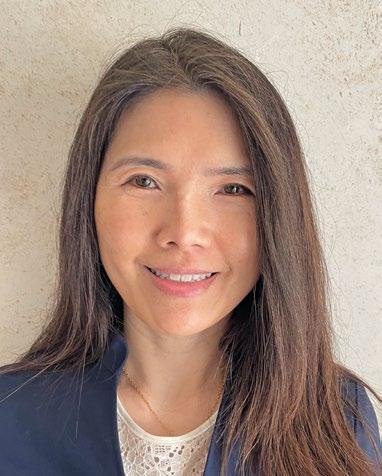
After graduating from the University of Michigan School of Dentistry, Dr. Jenny Lin moved to Houston, Texas, where she worked at a group practice for a couple of years before branching out and starting her own practice. Since 2001, her Omni Dental general dentistry practice has been located in the Houston suburb of Richmond.
As she reflects on her career, she said she feels gratitude for the excellent dental education she received at U-M. It was the culmination of the very reason her parents brought their family to this country from Taiwan when she was 10 years old – to ensure that she and her siblings had excellent educational opportunities.
As a pre-dent student at the University of California-Davis, she applied to and was accepted at top dental schools, including U-M and UC-San Francisco. She assumed she would attend the latter because it was close to where she was living with her aunt and uncle at the time. But plans changed
after a chance phone call between her aunt and Jed Jacobson, the admissions director at the U-M dental school.
Jacobson had called to follow-up on whether Jenny had made her dental school decision. Jenny was away on a trip, so Jacobson talked instead with Jenny’s aunt. He delivered his most convincing argument for why he hoped Jenny would choose U-M. “My aunt was impressed. She said he was so caring and professional that she thought I would be better off going to Michigan. She felt like the professors would be willing to share their wealth of knowledge.” Jenny’s uncle, an educational counselor with knowledge of the higher education landscape, agreed. And that’s how Jenny ended up halfway across the country at U-M.
“What I remember the most is how the professors were passionate about dentistry and how they taught us to do everything right, the correct way, don’t take shortcuts. That’s still what I do today. I felt like they made all of us very competent by the time we graduated.” That was proven in her first
work setting when other recently graduated dentists from other schools were not as experienced and capable with certain treatments. “Some would come to me for help and consult with me as though I was a clinical instructor. So I was really proud of how Michigan had taught me to be able to tackle things on my own. I was ready to practice.”
Lin has been a regular financial contributor to the school over the years, often designating her gifts for student scholarships. Her support of the school is a thank-you for the excellent education and also a thank-you for a Mette Scholarship she received at a time when her father had become disabled and was no longer able to work.
“If we give back, the school can continue to be on top and stay competitive and attract qualified students or students in need. I feel like it is important because we were recipients of a great level of education and it allows us to have the edge over other dentists. I feel because of that, we should be able to give back.”
The very first recipient, Dr. Steve Ouwinga (DDS 1998), purchased Smith’s orthodontics practice in Escanaba when Smith retired. The importance of passing-the-torch from retiring dentists to new dentists is a major concern of dentists across northern Michigan and the U.P. “It is really, really needed in our area in Delta County,” Smith said. “We only have about 16-18 dentists in the Escanaba and Gladstone area. And that hasn’t changed. There were about that many when I got there and it’s still about the same. So many of the dentists – about 10 – want to retire. So it’s important to get kids into dental school who are interested in having a career there. We need that because we’re going to be really hurting in about five years when dentists start retiring.”
Smith is pleased to report that he knows at least two students entering dental school this year who plan to practice in the U.P. once they graduate. His grandson, Ben Kelly,
and Ben’s fiancée will be first-year dental students at U-M this year.
In an interesting mix of dental school history and family genealogy, Ben is also the grandson of Nelson Smith’s longtime friend from dental school, Mike Kelly. The families were linked when one of Nelson and Dawn’s daughters, Jessica, married Mike’s son, Dr. Scott Kelly, who continues the Kelly family practice in Gladstone. Ben will be the fourth generation of the Kelly family dentists dating to his great-grandfather George, and he’ll be the third Smith generation after Nelson and his nephew, Dr. Aric Smith, an endodontist in Grand Rapids, Michigan.
Nelson Smith knows family traditions alone won’t supply enough new dentists, so it’s important to cast a wider net. That’s why he isn’t shy about sharing his testimonials for dentistry in the U.P. “The opportunity is there. Trust me,” he says. “It is a wonderful area to build a practice. If you are not from there, you don’t fully realize the potential.”
Smith frequently encounters his former patients who contribute in myriad ways to the fabric and success of the EscanabaGladstone area. They are confirmation of the importance of providing easily accessible and excellent oral healthcare across the region.
“I was fortunate enough to have Steve Ouwinga come back and purchase my practice, and he’s doing it even better than I did,” Smith said. “So it’s a good feeling to see what you built and have someone come in and make sure it is done with the same quality and to the same satisfaction of the patients.”
He says he is still an interested observer of how Dr. Ouwinga is doing with his former practice, but retirement has its benefits. “I still go into the office,” he says, pausing for effect. “I go in and eat their doughnuts and drink their coffee.”
32 M Dentistry | Spring 2023 ALUMNI
Profile (Continued)
Alumni
Alumni News
Michelle Arnett (MSDH 2016) received one of two special awards presented this year by the American Dental Education Association to commemorate its 100th year. The ADEA President Centennial Awards for Oral Health Education were presented to a dental school faculty member and an allied dental faculty member to honor mid-career educators who make a significant and positive impact on oral health education. Arnett is an assistant Professor in the Department of Primary Dental Care at the University of Minnesota School of Dentistry. After earning her MS from Michigan in 2016, she joined the school’s Dental Hygiene faculty. From 2015-2018, she taught in the entry-level and degree-completion BSDH programs and was a clinical research coordinator and practicing dental hygienist in the Department of Graduate Periodontics. Arnett moved to the Minnesota dental school faculty in 2018. She held a three-year leadership position on the ADEA Section on Dental Hygiene Education and was selected to serve as a member of the ADEA Allied Dental Competency work group that will drive allied oral education for the next decade.
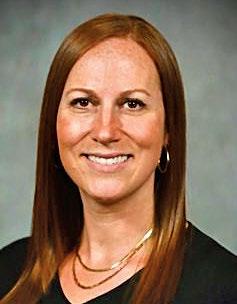
speaker of the MDA House of Delegates. She is the incoming chair of the American Dental Association Council on Ethics, Bylaws, and Judicial Affairs. Her community service in the Lansing area includes work with youth, church, arts, school and business organizations.

Dr. Debra Peters (DDS 1993) in January received the Silent Bell Award for Distinguished Service from the West Michigan District Dental Society (WMDDS). It is presented annually for outstanding service to community and profession by leaders who serve without fanfare or self-promotion, thus the “Silent Bell” designation. Peters retired in 2021 after she and her husband, Dan, owned Peters Family Dentistry for 28 years in Kentwood, near Grand Rapids. The dental society cited Deb Peters’ service to the profession, leadership and longstanding community activities. She served on numerous committees and task forces for the American Dental Association, the Michigan Dental Association and the WMDDS throughout her 28 years of practicing dentistry. She has made numerous presentations and given lectures to dentistry organizations and has written articles for various dentistry publications. She is a past president of the Michigan Dental Association and
Dr. William K. Lobb (MS 1961), professor and dean of the Marquette University School of Dentistry, will retire on June 30, 2023, after nearly 30 years at Marquette University, making him the longest-serving dental school dean in the country. Lobb received his DDS degree from the University of Alberta in Edmonton in 1977. He completed a general practice residency at the University Hospital in Edmonton, received a master’s degree in orthodontics from the University of Michigan in 1981, and a Master of Public Health degree from the Medical College of Wisconsin in 2008. In 2021, Lobb was awarded a Lifetime Achievement Award from the Wisconsin Dental Association, and in 2012 he received the William J. Gies Awards for Innovation as a dental educator from the American Dental Education Association.
Navy for two years before beginning his private practice. Alpha Omega was founded at the University of Maryland School of Dental Medicine in 1907 by students fighting discrimination against Jewish students, who were barred from many social organizations at the time. AO now has more than 100 alumni and student chapters in 10 countries. It founded two dental schools in Israel and established a program providing free oral health care to low-income Holocaust survivors. “I joined my first year of dental school and found it very meaningful,” Sonne said. “Alpha Omega has done remarkable things that make me very proud, and I am proud to have ascended to this position.”
Dr. Marvin Sonne (DDS 1973) of Farmington Hills, Michigan, in June became the International President of the Alpha Omega International Dental Society for a one-year term. Sonne had served since December 2021 as international president-elect. Sonne retired from his practice in October of 2021 after working as a dentist in Michigan, first in Woodhaven and then in Trenton, for more than 45 years. He served as a dentist in the


A School of Dentistry alumnus and adjunct professor was prominently featured in a national television report in March that raised serious questions about a dental device patients around the country say has damaged their teeth. Dr. George Mandelaris (DDS 1996), a periodontist who practices in the

33 Spring 2023 | M Dentistry ALUMNI
Michelle Arnett
Dr. William K. Lobb
Dr. Debra Peters
Dr. Marvin Sonne
Continued
Dr. George Mandelaris
Chicago area, was one of several people interviewed for an in-depth, two-part investigation by the national CBS News morning show, CBS Mornings, which has a daily audience of 3 million viewers. Mandelaris and other dental experts sharply criticized the Anterior Growth Guidance Appliance, or AGGA. Several patients are suing a Tennessee dentist who invented the device, also called the osseo-restoration appliance, saying it caused them irreparable harm. Mandelaris said he has examined several patients who used the device, including one whose resulting damage was “like a bomb went off in her mouth.” He added: “I’ve not seen one patient that has anything good come from this device. Nothing. This is snake oil. This is crazy.” Mandelaris said he found no peer-reviewed literature regarding the device and that the patients needed urgent treatment in order to prevent tooth loss. CBS reported that the AGGA was apparently never registered with the Food and Drug Administration, despite the agency's role in regulating medical and dental devices, and it remains unclear if the investigation will prompt an FDA review.
throughout Michigan, including three Michigan Dental Association Mission of Mercy clinics. Gingrich serves on the faculty of the Ferris State Dental Clinic and as a dentist for local nursing homes. She also participates in her local school’s free sealant program. Gingrich has served in leadership roles in the West Michigan Dental Society and the Michigan Dental Association, of which she was president in 2019.
implant position, allowing for more accurate and precise placement. The robot then indicates when he has achieved the appropriate depth. Another robotic arm helps adjust for any patient movement during surgery. In addition to his degree from U-M, Robinson holds a certificate in oral and maxillofacial surgery from Harbor-UCLA Medical Center in Los Angeles and is board certified in oral and maxillofacial surgery.
Dr. Irene Tseng (DDS 1986) of Livonia has been reappointed to the Michigan Board of Dentistry by Gov. Gretchen Whitmer to represent dentists for a term from September 29, 2022, to June 30, 2026. She was initially appointed to the board for a four-year term in 2018. The Michigan Board of Dentistry was formed to regulate the practice of dentistry and dental hygiene, authorize dental assistants, and certify specialists in the fields of orthodontics, endodontics, prosthodontics, pediatric dentistry, periodontics, oral and maxillofacial surgery, and oral pathology.


Dr. Margaret Gingrich (DDS 2004) received the Joseph B. Harris Mentorship Award from the Michigan Section of the Pierre Fauchard Academy earlier this year. The academy recognized Gingrich, whose private practice is in Big Rapids, for her mentoring of prospective dental and dental hygiene students, as well as for her dedication to patient outreach. She has participated in numerous foreign dental mission trips, including to Alaska and South America. She has also served as a volunteer dentist in various charitable mission projects
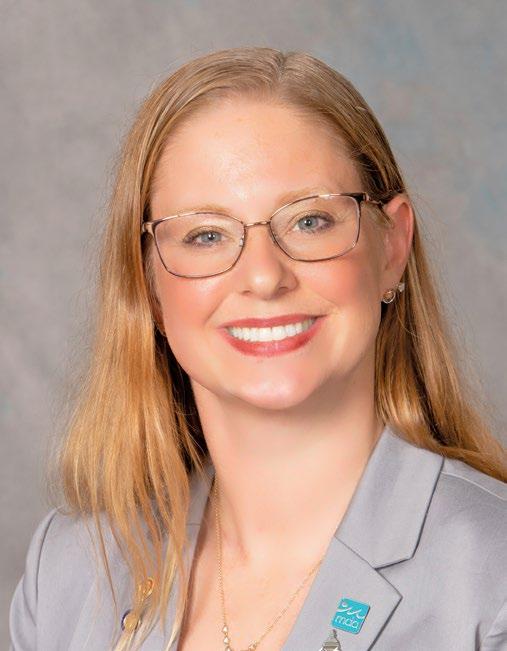
Dr. Allen Robinson (DDS 2009) was featured earlier this year on a Washington, D.C., television news report for his use of an FDA-approved robot that assists with the placement of dental implants. Robinson was the first oral surgeon in the Washington, D.C., area to use the Yomi dental robot from Neocis, the only FDA-approved dental robot on the market, and he was among the first to have it in the country. Many more practitioners across the country have since acquired it. Robinson said it provides a better patient experience in the execution of dental implant placement surgeries than working without robotic assistance, allowing more precise placement of implants and a less-invasive procedure. “I really believed in the technology and wanted to deliver a higher level of care,” he said. Using a CT scan of the patient’s jaws, Dr. Robinson determines the ideal location for implant placement. He is still in control of the handpiece during surgery, however the robotic arm physically guides his hand into the preplanned

School of Dentistry alumna Jessica Rickert (DDS 1975) was instrumental in facilitating a new agreement organizers hope will help fill the need for dental assistants in Michigan’s Upper Peninsula and increase access to dental care for American Indian residents in the area. The agreement will allow students at Bay Mills Community College, a tribally controlled college in the Upper Peninsula, to transfer to Northwestern Michigan College’s dental assisting program in Traverse City after one year. Students who then complete the yearlong program at NMC can take the state examination to become a registered dental assistant. Rickert said the scarcity of
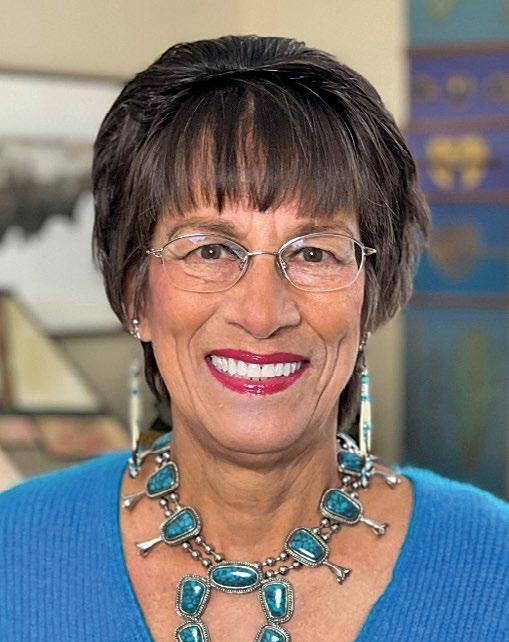
M Dentistry | Fall 2022 34 ALUMNI
Alumni News (Continued)
Dr. Margaret Gingrich
Dr. Allen Robinson
Dr. Irene Tseng
Dr. Jessica Rickert Dr. Yoshita Patel Hosking
Dr. Carlos Smith Receives ADEA Award for Leadership
Dr. Carlos Smith (DDS 2007), a faculty member at the Virginia Commonwealth University School of Dentistry, was honored at this year’s American Dental Education Association’s annual session with the inaugural Dr. Jeanne C. Sinkford Faculty Leadership Award.
The new award recognizes U.S. or Canadian faculty members who exemplify Sinkford’s legacy as a trailblazer in dental education embracing compassion, integrity, humanism and social justice. It is intended to inspire and empower the next generation of leaders in oral health education. Sinkford became the first female dean of a U.S. dental school in 1975 when she was appointed to lead the Howard University College of Dentistry.
In accepting the award, Smith encouraged the dental profession to continue to strive for more equity and social justice. “In the spirit of Dr. Sinkford, I charge each of us individually and collectively as a dental education community to go further, to take the risk, to envision a dental profession that even the least amongst us would see as trustworthy, just, accessible, free of oppression and the systemic ills that plague us today. We can get there together,”
Smith joined VCU School of Dentistry as a faculty member in 2015. In 2020, he was appointed as the school’s first director of

diversity, equity and inclusion. This spring he was promoted as the school’s inaugural Associate Dean for Inclusive Excellence, Ethics, and Community Engagement. He is an associate professor in the Department of Dental Public Health and Policy and directs the ethics curriculum, teaching a required ethics course that examines the roots of medical mistrust and systemic racism in health care. Smith is an ordained minister with a unique background combining ethics and dentistry. Much of his work focuses on dental student and faculty well-being, professional identity formation, belonging and inclusive excellence.
Sinkford praised Smith for his commitment to making the spaces within dental education and oral health more diverse and inclusive. “His love of learning is evident, and in teaching, he empowers students to see the entire person so
that they provide the compassion, empathy, respect and care that every person deserves. Most of all, he has the humility to go with his brilliance,” she said.
timely dental care is causing serious hardship in the Upper Peninsula. “With a registered dental assistant, a dentist can see about 60 percent more patients,” Rickert said. “They have a wonderful program at NMC. Dental assisting is such a great career, it’s really fulfilling and it’s necessary.” Rickert, who works with insurer Delta Dental to reach underserved communities, reached out to Bay Mills and Northwestern Michigan College with the hope of starting a dental assisting program at Bay Mills. Both schools were receptive and signed the articulation agreement in March. Rickert, a member of
the Prairie Band Pottawatomi Nation, was the first female American Indian dentist when she graduated from the U-M dental school in 1975. Now retired, she continues to travel frequently to speak on diversity issues at conferences and educational institutions around the country.
Dr. Yoshita Patel Hosking (DDS 2012), owner of Viera Pediatric Dentistry in Viera, Florida, has joined the board of the Space Coast Health Foundation. The foundation
is a grant-giving organization focused on ensuring access to quality health care for residents of Brevard County in central Florida. Patel’s previous community service includes volunteering her time and expertise on pediatric dental issues for specific children populations, as well as helping lead efforts to keep fluoride in public water systems on the Space Coast. Patel is married to another U-M dental school alum, Michael Hosking (DDS 2012), an endodontist who also practices in Viera.
35 Spring 2023 | M Dentistry ALUMNI
In Memoriam
Dr. Brien Lang of Ann Arbor, an international leader in the field of prosthodontics and former chair of that program at the dental school, died March 29, 2023 at the age of 88. Lang earned his DDS at U-M in 1961, practiced briefly, and returned to U-M to complete his MS degree in removable prosthodontics in 1965. He then joined the faculty and advanced through the ranks, becoming a full professor in 1972. He was a distinguished scholar, researcher and teacher, serving as consultant to numerous organizations and as both examiner and president of the American Board of Prosthodontics. He was a reviewer for the International Journal of Prosthodontics, a member of the editorial committee of the Journal of Implant Dentistry, and a member and vice chair of the editorial council for the Journal of Prosthetic
Longtime orthodontics faculty member Dr. Thomas R. Gebeck, Sr., of Grosse Pointe Woods, Michigan, died Feb. 8, 2023, at age 83. After completing his MS in orthodontics at U-M in 1968, he immediately joined the orthodontics faculty and taught through 1984. He returned in 1992 and continued to teach through 2016. He maintained a private practice in Grosse Pointe for 47 years and served numerous orthodontics organizations in leadership roles, including as an orthodontics examiner and lecturer both. He taught for the Charles H. Tweed International Foundation for Orthodontic Research and served as its president


Dentistry. His main research interests were in the area of complete denture prosthodontics with more than 70 journal articles and 10 chapters in textbooks. From 1994-98, he was the director of the University of Michigan Center of Excellence for Biomedical Research involving dental implants and CAD/CAM restorations. He took great satisfaction in teaching and mentoring students, receiving the annual Paul Gibbons Award for teaching excellence from students several times. He received the Jerome M. and Dorothy Schweitzer Research Award from the Greater New York Academy of Prosthodontics in 1994 and the Presidents Award (1995) and Daniel Gordon Award (1997) from the American College of Prosthodontics. He retired in 1998 after 33 years at the School of Dentistry.
from 1996-98. His travels for orthodontic education included lectures and Continuing Education courses across the U.S. and internationally to countries including France, Monaco, Italy, Romania, Guatemala, Brazil, Korea and Japan. He was president of the Michigan Society of Orthodontics and the Eastern component of the Detroit District Dental Society. He was a Michigan Specialty Board examiner and an Italian Board of Orthodontics examiner. Former Orthodontics Department Chair Lysle Johnston said of Gebeck, “He was a superb clinician and skilled teacher who thus served as a ponderable asset to the program.”
Dr. Gene Derricotte, one of the School of Dentistry’s most storied alumni both before and after he earned his DDS in 1958, died March 31, 2023, in San Antonio, Texas, at the age of 96. An Ohio native, Derricotte originally enrolled at U-M in mid-1944 and played on the U-M football team that fall as one of the university’s first AfricanAmerican athletes. After that first semester at U-M, as World War II continued, Derricotte left to join the U.S. Army. He transferred to the Army Air Corps and became a pilot with the famed Tuskegee Airmen, though he finished training after the war had ended. He returned to U-M in September 1946, entering the School of Pharmacy and resuming his football career. He was a leading running back, set records as a punt returner and played on the backto-back national championship football teams in 1947 and 1948. After graduation, Derricotte worked as a pharmacist in Detroit until 1954, then enrolled
at the U-M School of Dentistry, graduating in 1958. He practiced dentistry in Detroit for four years, then entered the United States Air Force Dental Service as a Captain, serving as a senior dental officer for the 2nd Air Division during 13 months in Vietnam. Earning numerous commendations, he rose to the rank of Colonel in 1974 and was named Command Dental Surgeon for the United States Air Force Academy in Colorado Springs. After a 26-year military career, he retired in 1985. He then became an Assistant Professor in the Department of Oral and Maxillofacial Surgery at the University of Texas Dental School in San Antonio until August 2002. U-M inducted Derricotte into its Athletics Hall of Honor in 1987. In 2007, he was one of six surviving Tuskegee Airmen awarded the Congressional Gold Medal, in recognition of their service to the United States.

36 M Dentistry | Spring 2023 ALUMNI
Pricilla “Polly” (Miley) Adams (BSDH 1955), Carmel, Indiana, Nov. 30, 2022.
Richard T. Beistle (DDS 1961), Buchanan, Mich., and Zephyrhills, Fla., March 1, 2022.
Thomas Bennett (DDS 1974), Paw Paw, Michigan, October 16, 2022.
Ellen (Charters) Blanchard (DH certificate 1964), Bay City, Michigan, Feb. 26, 2023.
Janebeth Schaberg Chapman (DH certificate 1959), Harwichport, Massachusetts, Jan. 1, 2023.
Albert Colman (MS prosthodontics 1960), Middle Haddam, Connecticut, Jan. 26, 2023.
Ronald D. Cucuro, Jr. (DDS 1961), Port Austin, Michigan, May 27, 2022.
James S. DeHudy (DDS 1974), Muskegon, Michigan, Dec. 9, 2022.
Danny Giltrow (DDS 1958), Ann Arbor, Michigan, Dec. 20, 2022.
Dorothy (Brown) Goodman (BSDH 1956), Grand Blanc, Michigan, Feb. 27, 2023.
Gary N. Gordon (DDS 1976), Naples, Florida, May 19, 2022.
Jerome Greene (DDS 1957), Denver, Colorado, Jan. 4, 2023.
Kenneth W. Hock (DDS 1955), Rochester, Michigan, June 10, 2022.
Elmer C. Lang (DDS 1956), Santa Cruz, California, October 31, 2022.
Ferris T. Laraway (DDS 1965), Cudjoe Key, Florida, formerly of Ludington, Mich., March 24, 2023.
Steven M. Miller (DDS 1979), West Bloomfield, Michigan, August 5, 2022.
Robert L. Mixer (DDS 1958), Muskegon, Michigan, April 7, 2023.
Helen Marie (DeGroat) Phillips (BSDH 1958), St. George, Utah, Oct. 2, 2022.
Donald Restauri, Jr. (DDS 1982), Howell, Michigan, Nov. 11, 2022.
Omar J. Salamen (DDS 2004), Northville Township, Michigan, November 12, 2022.
James O. Smith (DDS 1953), Traverse City, Michigan, Jan. 8, 2023.
Kenneth J. Steketee (DDS 1948), Grosse Pointe Farms, Dec. 26, 2022.
Clare Venema (DDS 1957), Fayetteville, Arkansas, Nov. 27, 2022.
Darwin “Jack” Weersing (DDS 1953, MS orthodontics 1960), Grand Rapids, Mich., July 20, 2022.
Kim D. Wright (DDS 1981), Lake Ann, Michigan, Jan. 15, 2023.
Albert Ziegler (DDS 1961), Grand Blanc, Michigan, Jan. 29, 2023.
We want to hear from you. Send us news about your achievements, awards or honors. Contact: SODalumnirelations@umich.edu University of Michigan | School of Dentistry 1011 N. University | Ann Arbor, MI 48109 Send Us Your News! Spring 2023 | M Dentistry ALUMNI 37
Thank You, Donors
Tommy Lau
DDS Class of 2024
Hometown: Ann Arbor, Michigan
Undergraduate Degree: Biomolecular Science, U-M
“My scholarship has allowed me to consider the endless possibilities in our profession, and I am really eager to find my niche within dentistry to make long-lasting impacts. As a first-generation college student, I have been able to conduct research and publish for the first time during dental school, because of the encouragement and confidence this scholarship has given me. My sincerest thanks to the donors who support student scholarships.”

Address Service Requested 1011 N. University Ave. | Ann Arbor, MI 48109-1078

 Samuel D. Harris Collegiate Professor of Dentistry
Samuel D. Harris Collegiate Professor of Dentistry











































 Dr. Stephen Meraw
Vidya Ramaswamy
Dr. Nicholas Shirey
Dr. Rogerio Castilho
Dr. Laurie McCauley
Dr. Stephen Meraw
Vidya Ramaswamy
Dr. Nicholas Shirey
Dr. Rogerio Castilho
Dr. Laurie McCauley




















































